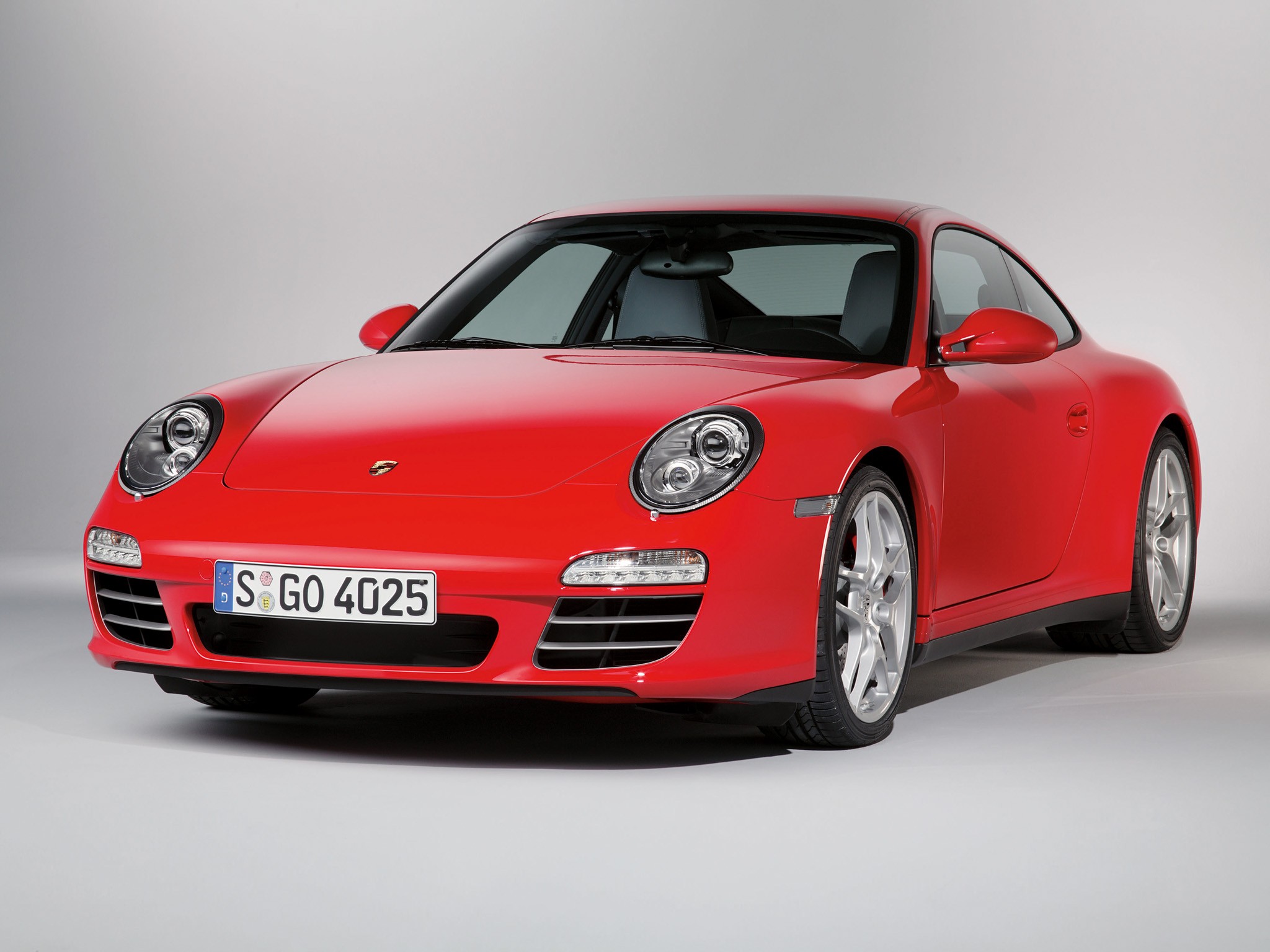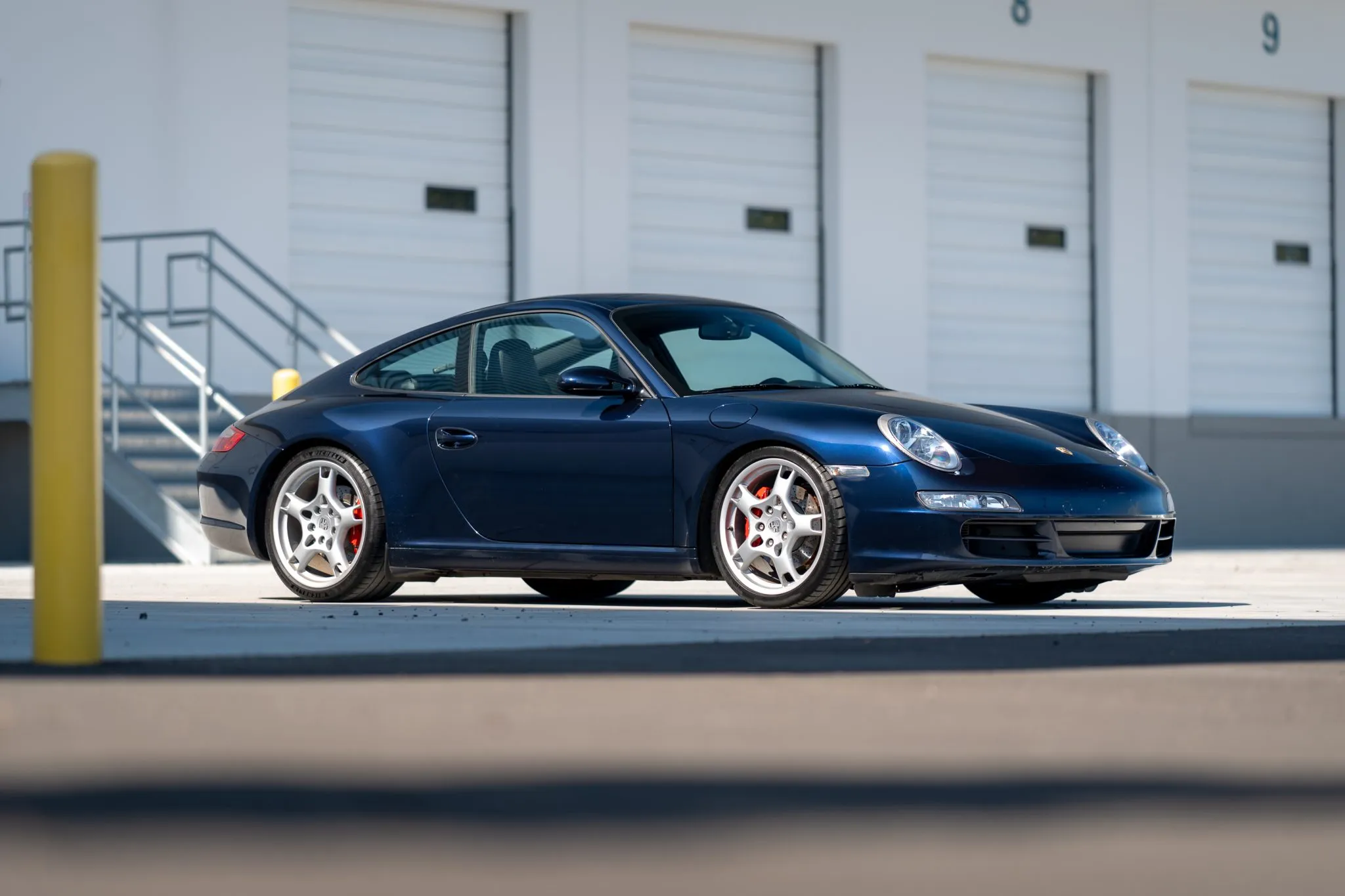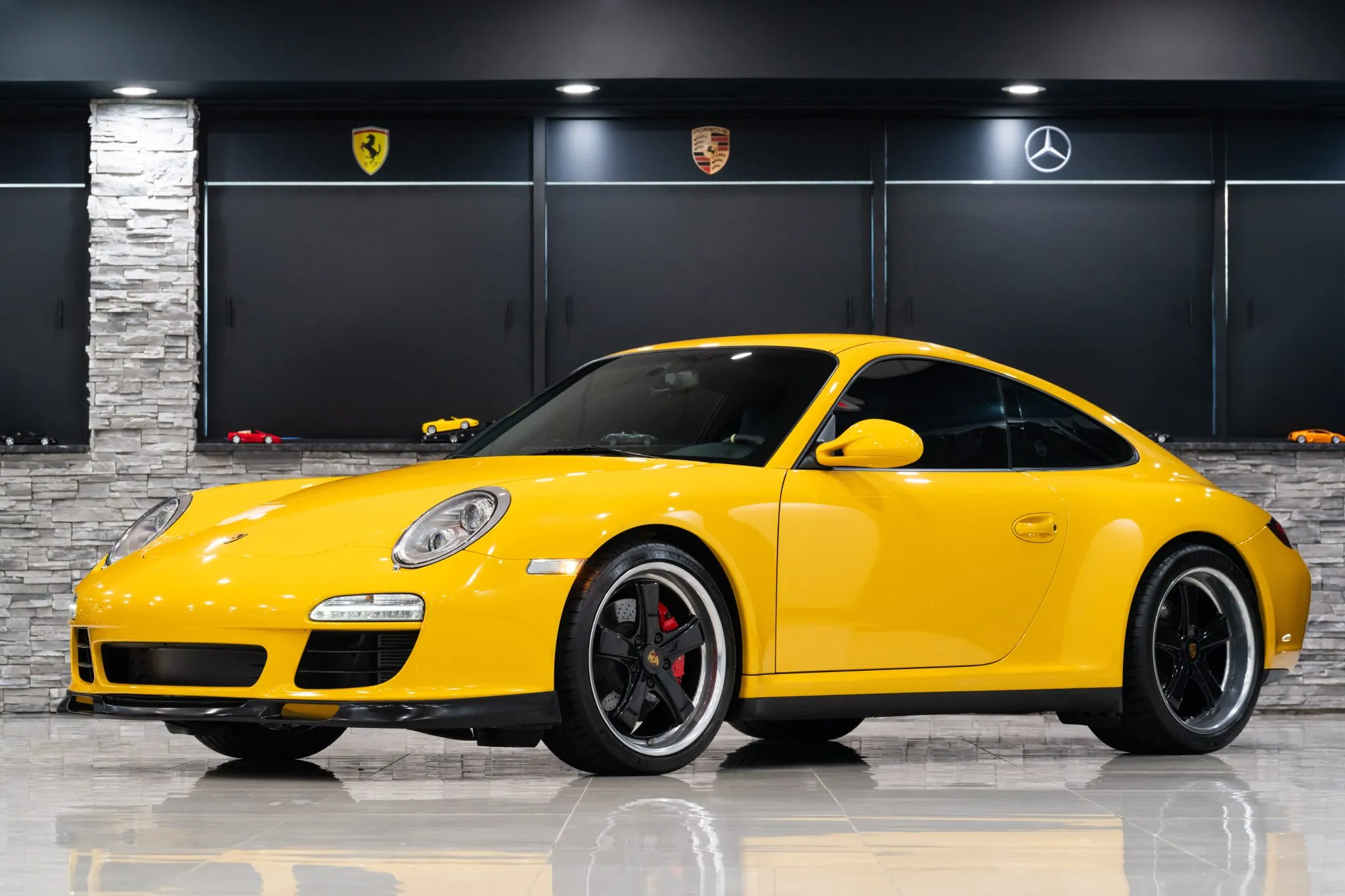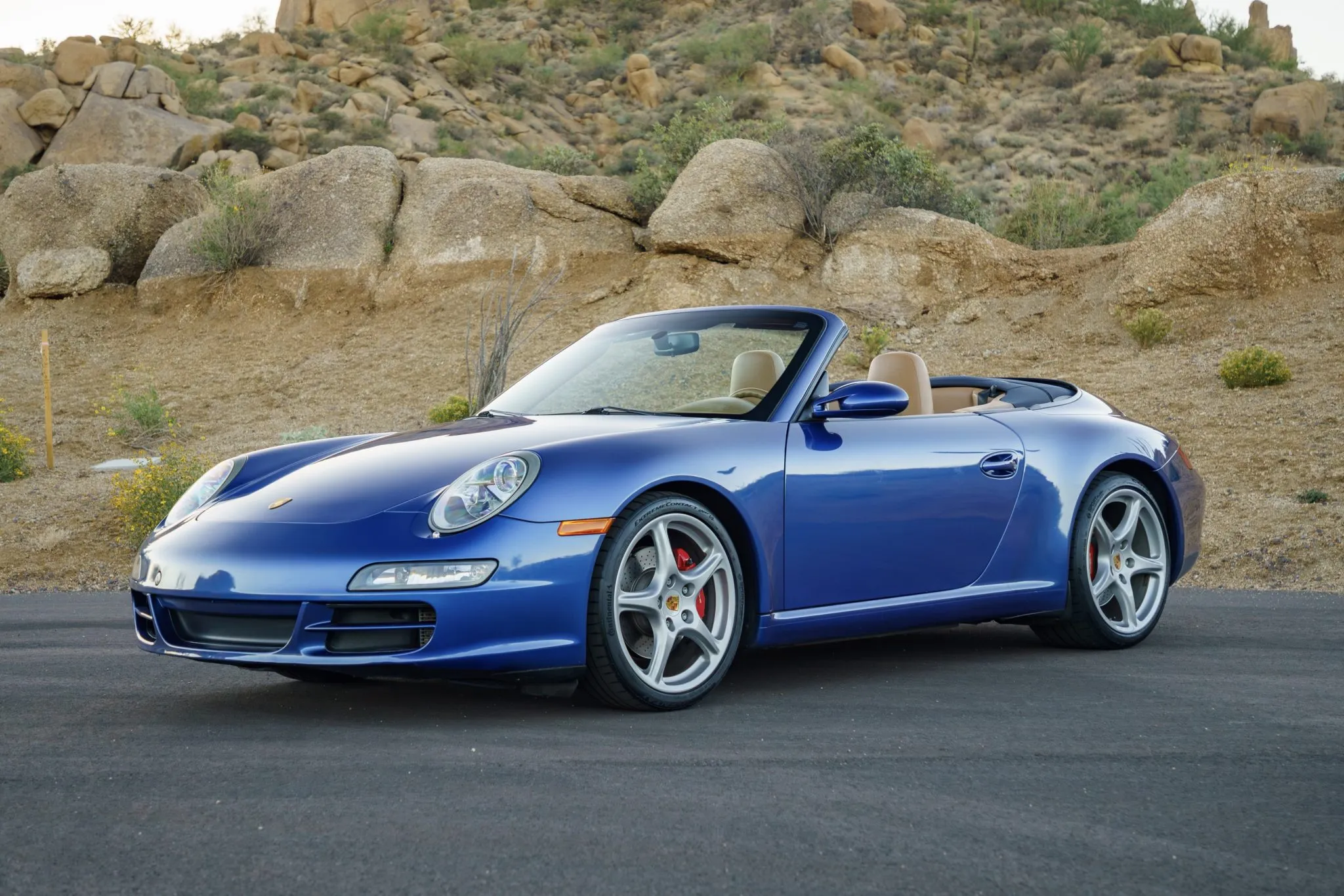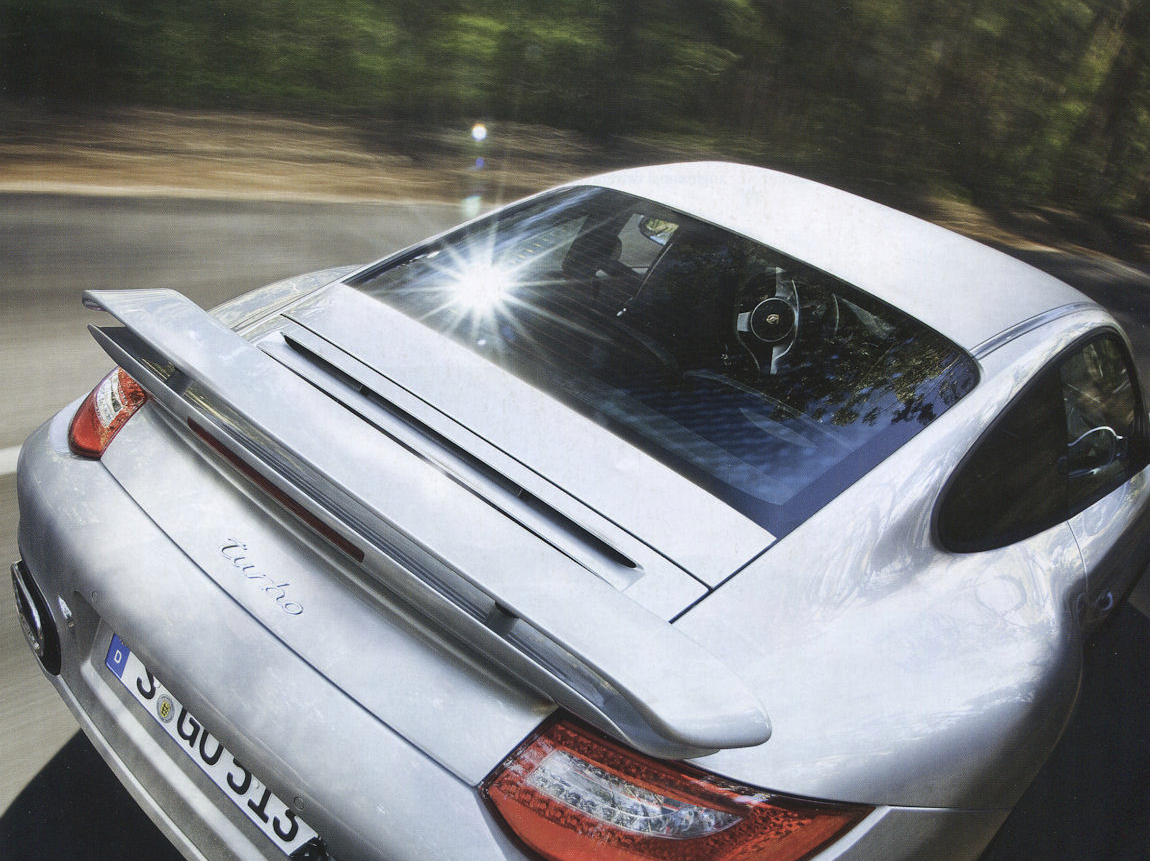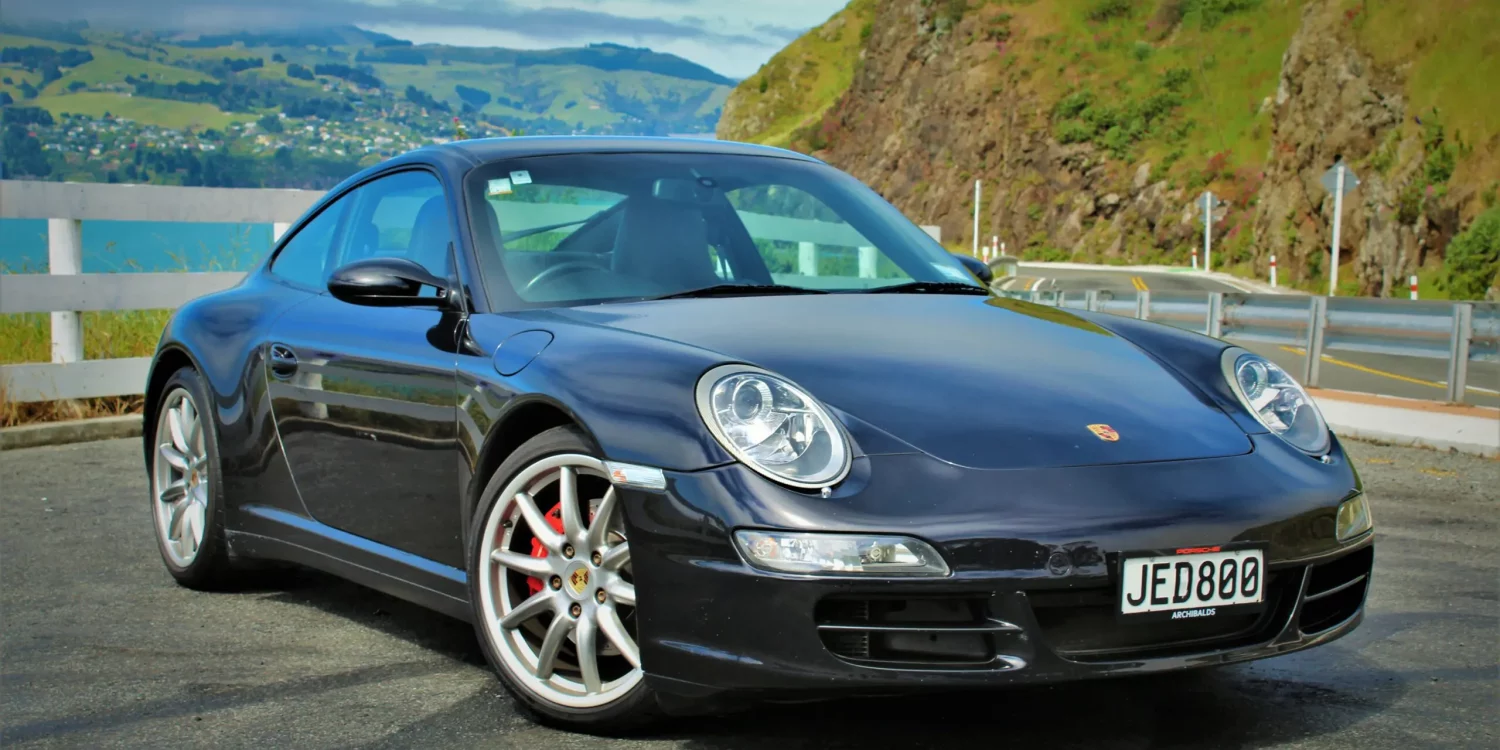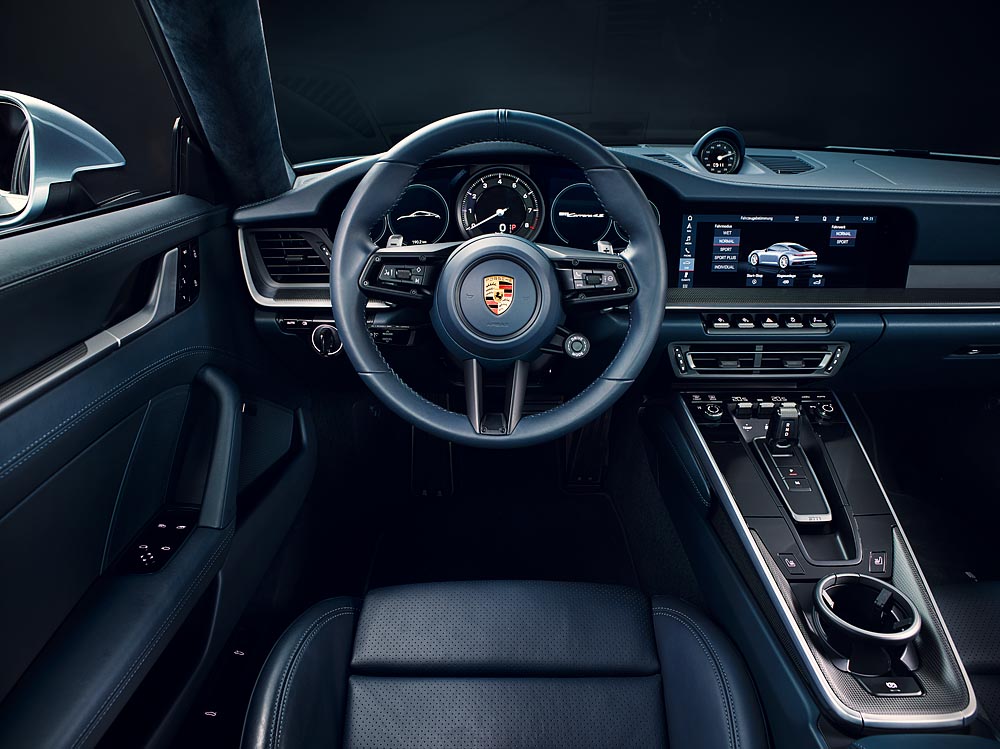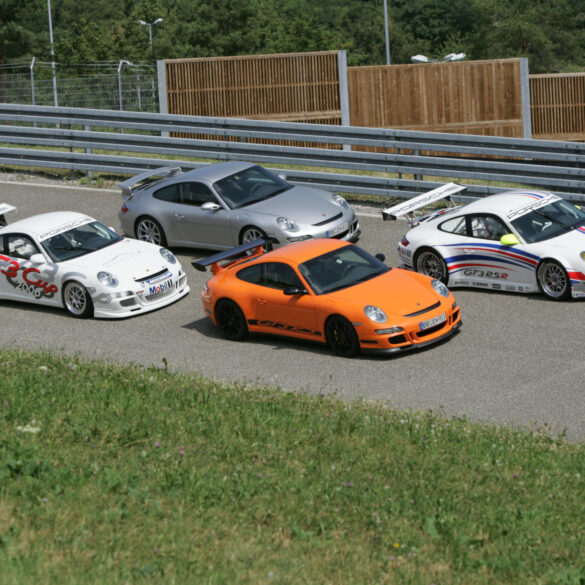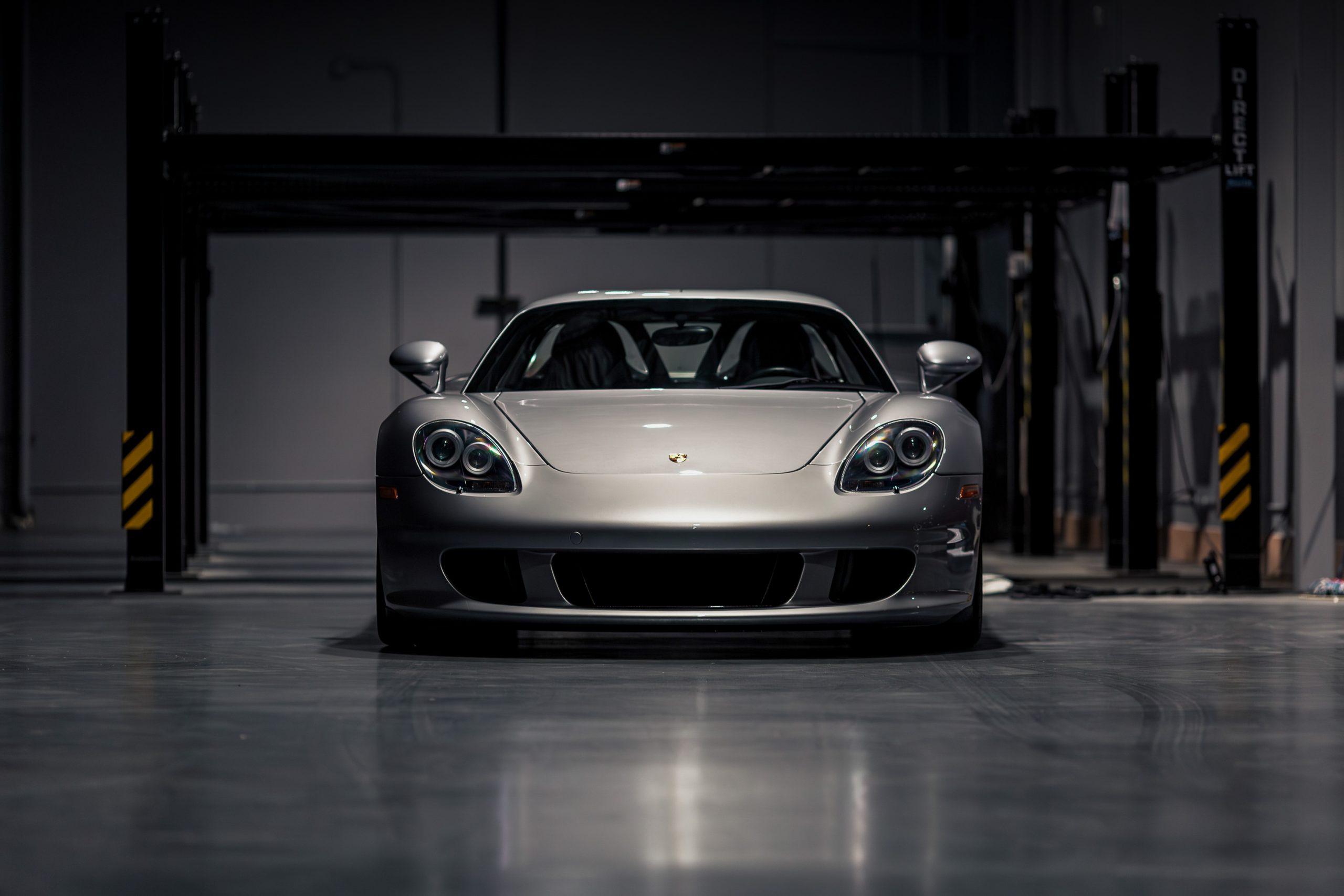Porsche 911 (997) Buyer's Guide
Buying a 997 Generation Porsche 911 (2005 - 2013)? Our Buyer’s Guide Covers Variants, Issues, Values, Tips, What To Expect & More.
The Porsche 911 (997) represents one of the most universally admired modern chapters in the 911 story — a generation that successfully blended classic design cues with contemporary performance, technology, and usability. Produced from 2005 to 2013, the 997 refined everything the 996 introduced, restoring more traditional styling while delivering sharper dynamics, improved interiors, and a broad range of variants that catered to purists, performance seekers, and everyday drivers alike. For many enthusiasts, the 997 strikes the perfect balance between analog engagement and modern capability, making it one of the most compelling 911s to buy today.
As a buying proposition, the 997 is remarkably versatile. From accessible Carrera models to ferocious Turbo and GT variants, it offers choices that span comfortable daily sports car to full-blown track weapon. It introduced improved engines, more sophisticated electronics, and in later years, the highly regarded PDK transmission, all while maintaining the unmistakable feel and identity of a true Porsche 911. With values now stabilising and certain models beginning to climb, the 997 also represents a generation where passion and smart purchasing increasingly overlap.
This Buyer’s Guide explores everything you need to know before committing to a 997. We break down the key models and variants, highlight common issues and ownership realities, analyze current market values, and provide expert guidance on what to expect behind the wheel and in long-term ownership. Whether you’re seeking a weekend icon, a thrilling daily driver, or a future classic with appreciation potential, this guide will help you navigate the 997 landscape with confidence and clarity.

Model History
In September 2004, Steve Sutcliffe, former TVR championship racer and long-time Autocar writer, got his eager hands on the first 997 Carrera. His anticipation was palpable:
My mind fizzes. Will it look good in the metal? Will it sound and steer like a 911? Of course, it will stop like a 911, but will it feel like a 911, will it intimidate like a 911?”
The 997 met all those benchmarks as far as Sutcliffe (and indeed, virtually all motoring hacks) were concerned, and this approbation has much to do with the 997’s growing appreciation today.
Arriving in the US in 2005, the 997 was based on the 996/986 platform—and, as before, was available in coupé and cabriolet variants, this time also joined by a Targa. The 997 is often described as a thorough ‘reskin’ of the 996. Although the 997 shared only its roof panel with the 996, this is true, but it understates the changes that the 997’s engineers decided they needed to make. In the eight years since the 996 was conceived, quite a list of improvements had accrued on their job list for the new model.
While the ‘hard points’ (for example, the wheelbase) of the 986/96 chassis remained, there were detail alterations to the underside. Grant Larson’s 997 styling model showed the car with 19” wheels. To accommodate these, initially an option, without raising the ride height, suspension components had not only to be redesigned, but their location points adjusted: wider tyres on larger wheels distribute stress differently besides requiring wider front and rear track and new subframes fore and aft to carry this.
The suspension also needed to cope with Porsche’s new PASM (suspension management), which lowered ride height by a centimetre. Besides being wider, the body itself befitted from more substantial crash protection—including use of steel from ThyssenKrupp, which had twice the tensile strength of material employed on the 996. Impressively, the 997 shell was 40% more rigid than the 996’s.
Under the hood, the 997 continued with the 996’s M96 3.6, its output boosted by 10bhp. For the first time since the original 911S of 1966, the 997 Carrera range featured an S version, which had more power (rather the wider body S signified on the 993 and 996). The M97 engine was bored out by 3mm making 3824cc, and as a result the Carrera S offered thirty more horsepower and foot pounds over the base 3.6.
While the five-speed Tiptronic continued with refinements to its software to hone response, Porsche abandoned Getrag, its manual gearbox supplier since 1952, for Aisin. The Japanese already supplied the Cayenne’s auto box, and one of the advantages of its six-speed was that it created less oil-churn and therefore used less energy.
The Aisin’s re-arranged gear sets also meant it required less space under the 997’s rear seat. All models, including the Targa, were available as two- or four-wheel drive.
Many commentators remarked on the similarities with the much-missed Porsche 993. The cabin too was admired: gone were the swoops and curves of the 996’s facia and door panels. The more smoothly integrated surfaces of the dashboard seemed more appropriate to the conservative 911, and fittings and materials were of a noticeably better quality. Only the centre console with its confusing array of controls, dubbed a ‘button fest’ by one observer, struck the slightest negative note.
Porsche built 118,000 of the first generation 997 (excluding Turbos and GT3s) before the introduction of the second gen, shown in Europe in late 2008. Visually, this was very similar, differentiated essentially by front and rear light treatments. The real interest was in the new 9A1 engine. It came in two versions: a 3.6 and a 3.8 for the S as before, but was a total redesign.
The cylinder head had been completely re-engineered to improve rigidity and coolant flow—cracking had affected the earliest M96 engines, though was much rarer with the M97, and the troublesome intermediate shaft had been eliminated, the camshafts driven directly from the crank. The new engines weighed 6% less than their predecessors.
In fact, Porsche made less of this re-engineering than might have been expected, preferring to concentrate attention on the Siemens new direct-injection, which replaced the 911’s traditional Bosch engine management systems.
Direct-injection was a direction top-end manufacturers were taking anyway, because though its high-pressure pumps and ancillaries were more expensive, CO2 norms were forcing them down this route. Karl Ludvigsen suggests that with litigation concerning the M96 engine still current, trumpeting too obviously about the improvements of the 9A1 might be construed as admitting to shortcomings in the previous unit.
It should also be said that Porsche had never intended to have two engine ranges for the 911—one for the Carrera and the other for the GT3 and Turbo models. The 9A1 flat-six family was essentially a rationalisation conceived to provide one engine design for the entire Porsche sports car range.
The other gen 2 upgrade, one which Porsche could rightly be proud of, was double-clutch transmission, PDK. A technology which the company had had on the stocks since the 1980s, it wisely waited till its software was entirely reliable (and learned from VW-Audi’s mixed experience marketing its similar DSG system some years earlier) before launching PDK on the 911.
Although costing about $3000 more than the manual gearbox, the response and modularity of PDK immediately consigned torque converters to the museum—and it is no surprise that subsequently, most 911s and Boxster-Caymans have been sold with the double clutch gearbox.
The 997 gen 2 cabin had only minor alterations, and the most significant changes to the gen 2 were its technical upgrades such as the new Siemens management, which allowed amongst other improvements more subtle traction control for the 4×4 models.
Why the 997 Generation Porsche 911 (2005 - 2013) is a Unique & Awesome Sports Car to Buy
The Porsche 911 (997) occupies a special place in the 911 timeline because it feels like the generation where everything finally came into harmonious balance. After the technical revolution of the 996, the 997 refined the formula with more classic 911 styling, a richer interior, sharper dynamics, and enhanced performance across the range. It reintroduced timeless round headlights and more traditional proportions while retaining the mechanical sophistication Porsche had developed, creating a car that feels both modern and unmistakably rooted in heritage. For many enthusiasts and collectors, the 997 represents the point where Porsche perfected the "usable every day, thrilling every weekend" sports car formula.
What truly makes the 997 unique is its breadth of character. It can be a refined grand tourer, a ferocious track weapon, or a beautifully balanced driver’s car depending on the variant. The Carreras offer an intoxicating blend of precision steering, rear-engine traction, and engaging flat-six character, while the Turbo delivers effortlessly savage acceleration without sacrificing comfort. Meanwhile, the GT3 and GT3 RS models introduced some of the most revered driver-focused Porsches ever built, achieving near-mythical status for their rawness and motorsport pedigree. Yet even the most “basic” 997 Carrera retains a level of tactility and feedback that feels increasingly rare in today’s performance landscape.
From an ownership perspective, the 997 also shines as a smart and emotionally satisfying purchase. It combines modern reliability, strong build quality, and a more premium, durable interior with the analog engagement many drivers still crave. Whether used daily or reserved for special drives, it delivers consistent enjoyment without the fragility concerns of older air-cooled cars. Values across the generation are now stabilising, with certain models already showing appreciation, making the 997 one of the most compelling intersections of passion, performance, and long-term desirability in the entire 911 lineup.
This is one special 911 generation. It is the last 911 where the driver can almost discern all four corners from the driving seat, a properly maintained 997 will be an exhilarating drive, instantly responsive to both steering wheel and throttle pedal. Except at the highest speeds, it corners as if on rails, ultimately understeering. On dry roads, the rear tires will not lose adhesion unless the driver really does not understand the laws of physics; on wet surfaces, PSM will often rescue most minor slides before the driver can, but wet, and especially cold, damp roads should elicit caution in any driver.
A 997 that is off-song will display a lack of precision in corners that the experienced Porsche hand will notice straight away as will any reluctance to reach high revs: a flat six in proper fettle should race to its limiter with alacrity.
Porsche 911 (997) Models & Variants - A Quick Primer for Potential Buyers On The Variants & Specials To Think About.
We already have ultimate guide to the sixth generation Porsche 911 so we don't want to repeat everything here. Instead, we will give you a quick primer and summary about the main 997 911 variants, some of the core model year changes and we will talk about some special editions worth noting as you think about your potential purchase. The Porsche 997 (2005–2012) is often seen as the generation that restored visual and emotional continuity to the 911 after the controversial 996 while preserving the technical progress that made the modern 911 such a formidable performance machine. It blends traditional Porsche design cues with modern performance engineering, and its wide variety of variants makes it one of the most nuanced and rewarding 911 generations to understand as a buyer or collector.
Key Variants & Differences
The 997 Lineup in Context
The 997 is split into two distinct phases:
997.1 (2005–2008) – Introduced with updated styling and evolved versions of the M97 engine.
997.2 (2009–2012) – Facelifted models received direct fuel injection (DFI), improved reliability, PDK transmission, and refined technology throughout.
This division is critical, as it influences performance, desirability, and long-term ownership costs.
Core Carrera Models: The Heart of the 997
Carrera (C2)
The rear-wheel-drive Carrera is the foundational expression of the 997. Early models used a 3.6-liter flat-six producing 325 hp, while later 997.2 models increased power to 345 hp and introduced sharper throttle response and improved efficiency. These cars provide perhaps the best balance of performance, comfort, and classic 911 character of any modern generation.
Carrera S
Upgrading to the Carrera S added a 3.8-liter engine (355 hp in 997.1, 385 hp in 997.2), larger brakes, PASM adaptive suspension, and more aggressive styling.
It’s widely considered the sweet spot for enthusiasts wanting a more visceral driving experience without the hardcore nature of GT models.
Carrera 4 & 4S
The all-wheel-drive variants deliver added traction and stability, making them excellent for year-round use and high-speed touring.
Like their rear-drive counterparts, the 4S versions gain the wider body shell and enhanced visual presence, often viewed as among the most attractive road-going 997s.
Transmission: Manual, Tiptronic & PDK
Early 997.1 models offered a 6-speed manual or Tiptronic S automatic.
With the advent of the 997.2, Porsche introduced the groundbreaking PDK dual-clutch transmission, radically improving shift speed, efficiency, and performance while retaining everyday usability.
While purists still favor the manual, PDK has become highly respected for its performance advantage.
High-Performance & Enthusiast Models
997 Turbo
The 997 Turbo used a 3.6L Mezger engine with variable turbine geometry (VTG) turbochargers, producing 480 hp, later rising to 500 hp in the Turbo S. It combines devastating speed with everyday drivability, representing one of the most complete supercars of its era.
997 GT3
The GT3s are the ultimate expression of naturally aspirated 997 performance. Featuring the Mezger engine, less weight, focused suspension, the GT3 and GT3 RS remain the most coveted modern analog driving experiences.
997 GT2 & GT2 RS
The GT2 stripped away all-wheel drive and added twin turbochargers, delivering ferocious power to the rear wheels only. The GT2 RS pushed this further, becoming one of the most extreme road-going 911s ever built.
Specialist Variants & Cult Favorites
Carrera GTS
Introduced late in the lifecycle, the GTS bridged the gap between Carrera S and GT3. Featuring a widened body, sport suspension, center-lock wheels, and a 408 hp engine, it’s regarded as one of the most complete road-focused 997s.
Sport Classic
Limited to just 250 units, the Sport Classic revived iconic styling elements like the ducktail spoiler and Fuchs-style wheels, celebrating Porsche heritage.
Speedster
Extremely rare and highly collectible, the 997 Speedster combined exclusivity, unique bodywork, and a pared-back ethos.
Body Styles & Visual Differences
Coupe – Most rigid and performance-focused.
Cabriolet – Open-air luxury with minimal compromise.
Targa 4 / 4S – Unique glass roof system with AWD only, blending performance and novelty.
Styling refinement returned the classic circular headlights and muscular stance that defined earlier generations, making the 997 more emotionally appealing to traditionalists.
Mechanical Differences: Why 997.2 Matters
The move to direct fuel injection, revised electronics, and the improved PDK transmission made the 997.2 significantly more reliable and modern-feeling. It also addressed concerns around engine issues found in earlier variants.
Choosing the Right 997 Variant
A base Carrera offers a pure and engaging 911 experience. The Carrera S and GTS deliver heightened drama and performance. The Turbo models provide effortless supercar pace, while the GT family is all about uncompromising track capability.
Model Year Changes (2005-2013)
The 997.1 & 997.2
The 997 is widely considered the “sweet spot” modern 911 — preserving classic proportions and driver engagement while integrating meaningful performance, safety, and usability advances.
Over its eight-year lifecycle, Porsche refined the platform substantially, culminating in the much-improved 997.2 update.
2005–2008: Porsche 997.1 – The Return to Classic Form
The 2005 model year marked the introduction of the 997, replacing the controversial 996 and restoring more traditional 911 design cues.
Key Early Characteristics:
Return to round headlights, abandoning the 996’s shared Boxster lamps
Revised 3.6L (Carrera – 325 hp) and 3.8L (Carrera S – 355 hp) engines
Hydraulic power steering
More classic dashboard design with improved materials
PASM optional (standard on S)
Revised suspension for sharper handling
6-speed manual or 5-speed Tiptronic
Updates Through 997.1 Lifecycle:
Progressive refinement of electronics and interior quality
Introduction of Sport Chrono Plus enhancements
Minor reliability improvements (IMS bearing revisions but still a concern)
Expanded model range including Targa, Cabriolet, and AWD variants
997 GT3 launched with track-oriented setup
Introduction of the Turbo (997.1) in 2007:
480 hp, VGT turbochargers
First 911 Turbo to use VGT technology
Why 997.1 matters: These models blend classic 911 styling with modern performance but retain the IMS bearing discussion point in Carreras.
2009: The Critical Turning Point – 997.2 Begins
Just like with the 996, 2009 marked a major technical overhaul.
Major Changes Introduced:
All-new direct fuel injection (DFI) engines:
3.6L Carrera: 345 hp
3.8L Carrera S: 385 hp
Replacement of Tiptronic with the PDK dual-clutch
Revised PCM infotainment system with touchscreen
LED running lights and updated taillights
Improved fuel efficiency and emissions
Elimination of IMS bearing issues in DFI engines
Improved reliability and thermal management
Why it matters: 997.2 models represent the most reliable and technologically advanced version of the 997 platform.
2010–2012: Refinement and Performance Growth
These years saw the platform reach peak maturity.
Notable developments:
Continued improvements in PDK programming
More powerful and responsive engines
Improved stability control and traction management
Subtle interior upgrades
Expanded options and special editions
Key model introductions:
997 GT3 RS 3.8 and 4.0
997 Speedster (extremely rare)
GTS models introduced in 2011:
More power, wider body, sport-focused tuning
Became instant modern classics
2013: Final Year of the 997
The last 997s rolled off the line in 2013.
Highlights:
Final production of Carrera and Carrera S models
Highest build quality and component refinement
Very limited production variants
End of the “compact, classic proportion” 911 feel
These cars carry unique appeal for being the final 911 before the noticeably larger 991 platform.
Expert Buying Perspective
Best daily driver & reliability: 997.2 (2009–2013)
Most characterful feel: Early 997.1 manuals
Best investment potential: GTS, GT3 RS 4.0, Speedster
Best balance of modern + analog: Manual 997.2 Carrera S
Final Expert Take
The 997 represents a masterful bridge between classic and modern 911 philosophy.
While the 997.1 restored the soul and styling purists demanded, the 997.2 perfected the formula mechanically and technically.
If you want a modern-feeling 911 that still feels compact, engaging, and unmistakably Porsche, the 997 remains one of the finest choices Porsche has ever produced.
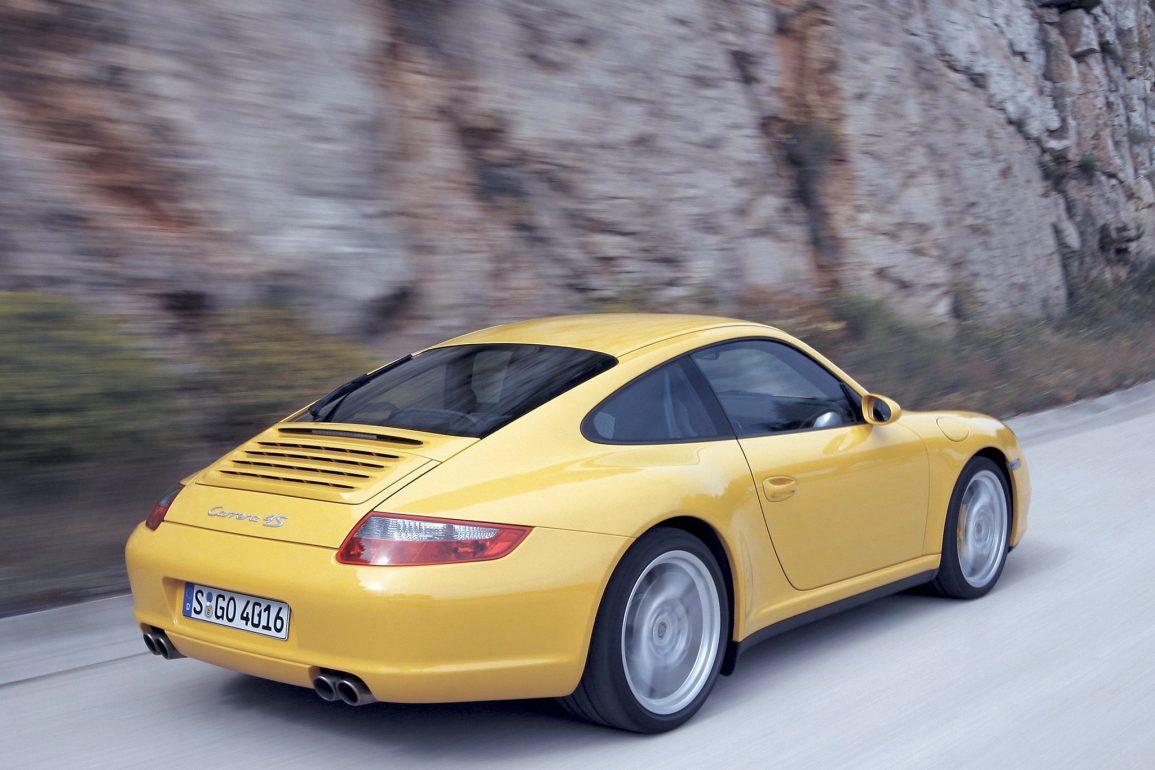
997 Generation Porsche 911 Market Value & Pricing
The price differential between generations 1 and 2 is around 30% and the S usually costs 10% –15% more than a Carrera in comparable condition and age, reflecting their original retail price differential. The stock advice is always to buy the best you can afford, but purchasers should not be put off from a good gen 1: these 997s are all older cars now and condition and supporting service history should be your primary judging criteria. Here is an expert-level breakdown of approximate U.S. dollar price bands for the Porsche 911 (997) generation (2005-2013) across the full model spectrum (Carreras, 4/4S, Turbo, GT3/RS, etc.). These are broad estimates as of 2025, and actual values will vary by variant, condition, mileage, documentation, region and spec.
What Are 997 Porsche 911s Worth?
The price of a Porsche 911 from the 997 generation varies widely based on condition, originality, model variant, and desirability. Below is a breakdown of pricing into five categories—ranging from restoration projects to concours-level examples—along with insight into what buyers can expect in each bracket.
Project / High-Mileage Drivers
$20,000 - $35,000
At the bottom end of the 997 market are cars that need substantial work, have very high mileage (100k+ miles), deferred major maintenance (clutch, suspension, brakes, service history gaps), and possibly cosmetic wear or damage. Most typically these are base Carrera models (Carrera or Carrera 4) with non-ideal transmission or option combinations. While bargains, they carry risk and budget for investment beyond the purchase price so be prepared.
Good Daily/Driver Quality
$35,000 - $55,000
This bracket represents 997s that are in solid mechanical order, have moderate mileage (50k-100k miles), appear well cared for, and have decent service history though not perfect. Includes standard Carreras, 4/4S models, and perhaps earlier or less desirable Turbo/GT3 variants in higher mileage. Condition will be good but not show-room; some cosmetic wear is acceptable. These are usable, enjoyable sports cars without paying “collector” dollars.
Fully Sorted Enthusiast Examples
$55,000 - $90,000
Here we begin to see low- to moderate-mileage examples (<50k miles), strong documented service history, desirable specs (manual gearbox, sport seats, rare colours, etc.), and variants like Carrera S, Carrera 4S, earlier GT3s in good condition. These cars appeal to serious enthusiasts looking for balance between performance, condition and value. They may not command the rare-variant premium yet but are much higher quality and have stronger appreciation potential.
Desirable / Collector-Grade Drivers
$90,000 - $150,000+
This tier includes low-mile, excellent-condition 997s with strong provenance, rare specifications, special editions, and performance models like GT3 (later years), early Turbos with manual gearboxes, desirable wide-body Carreras (4S) in rare colour combinations. These cars are increasingly viewed as modern classics with investment potential and are priced accordingly for their desirability and condition. Some awesome cars in this price range that are good future investments.
Limited Editions / Top Spec Variants
$150,000 - $300,000+
The most exclusive models: GT3 RS, GT3 RS 4.0, GT2, ultra-low-mile manually-geared Turbos, special-edition cars with limited production. Values here are driven more by rarity, provenance, pedigree and collector demand. Some examples are already well into this range and may go higher depending on spec, history and condition. For example one market guide reports 997.2 Turbo manuals with ~30k miles selling for big dollars and the very top low-mile examples likely significantly higher.
Factors That Affect Value
Variant & Model Hierarchy
The single most powerful influence on value in the 997 market is the specific model and variant. Standard Carrera models form the foundation of pricing, while Carrera S and the wide-body Carrera 4S sit a meaningful step above due to performance and visual desirability. Above those, the Turbo, GT3, GT3 RS, and GT2 occupy an entirely different stratosphere, driven by motorsport pedigree, limited production, and emotional appeal. As the market matures, the price gap between “ordinary” Carreras and performance-focused variants continues to widen.
Condition & Overall Presentation
Once the model is identified, condition becomes the most visible value driver. Cars with pristine paint, well-preserved interiors, straight bodywork, and tight mechanical condition consistently command strong premiums. Conversely, tired cosmetics, visible wear, deferred maintenance, or evidence of poor repairs will significantly suppress value, even on otherwise desirable variants.
Mileage
Mileage plays a strong psychological and financial role in the 997 market. Low-mileage examples are consistently rewarded with higher prices and stronger perceived collectibility, especially when condition supports the odometer reading. While well-maintained higher-mileage cars can still be excellent drivers, market preference clearly favors lower-mile examples for long-term value retention.
Service History & Maintenance Records
Comprehensive service history is critical for confidence and valuation. Detailed records demonstrating regular servicing, key preventative maintenance, and specialist care heavily influence price. This is particularly important for early 997.1 models where evidence of proper engine care helps mitigate concerns around IMS and bore scoring risks. Lack of documentation introduces uncertainty and typically results in downward price pressure.
Specification & Factory Options
Options and specification refine desirability significantly. Manual transmissions are strongly preferred by purists and collectors, while factory sport seats, PASM suspension, limited-slip differentials, PCCB brakes, rare colors, and special interior trims add to appeal. Well-optioned cars that reflect performance intent or rarity consistently outperform sparsely specified examples.
Originality vs Modifications
As the 997 becomes increasingly viewed as a modern classic, originality is gaining importance. Factory-correct cars with original wheels, paint, interiors, and components appeal to the broadest buyer base and retain value more effectively. While tasteful, reversible upgrades can still be attractive to enthusiasts, heavily modified or poorly executed changes significantly reduce long-term desirability.
Ownership History & Provenance
A clear and stable ownership history enhances value. Cars with longer-term owners, consistent stewardship, and careful use inspire far more confidence than those with frequent transfers or unclear pasts. Provenance becomes especially important for higher-end variants where buyer scrutiny is more intense.
Rarity & Limited Production
Scarcity plays a direct role in pricing power. Low-production models, special editions, rare factory specifications, and limited color combinations command stronger long-term demand. The more irreplaceable a specific configuration becomes, the more resilient its market position tends to be.
Market Sentiment & Cultural Trends
Broader market forces also influence value. Growing nostalgia for naturally aspirated engines, hydraulic steering, and pre-hybrid performance cars has strengthened enthusiasm for the 997. As newer generations become increasingly digital and isolated, the 997’s balance of analog feel and modern usability continues to enhance its appeal.
Future Collectibility Potential
Finally, perceived long-term desirability shapes present-day pricing. Cars that combine rare variants, strong documentation, originality, and emotional appeal are increasingly seen as appreciation candidates. The market is clearly stratifying, with top-tier examples pulling away while average cars stabilize or rise more slowly.
Together, these factors determine where a 997 will sit not only today, but how it will perform over time. The most valuable examples are those where model desirability, condition, specification, history, and authenticity intersect.
Investment Potential
Overall Investment Landscape
The 997 generation now sits firmly in the sweet spot between modern performance car and emerging collectible, making it one of the most attractive 911s from an investment perspective.
It represents the last widely available naturally aspirated hydraulic-steering 911 before the shift toward heavily digitalized systems, which has created strong nostalgia-driven demand.
While not every 997 will become a blue-chip asset, the generation as a whole has transitioned into a phase of growing long-term stability and selective appreciation, particularly for well-specified, original examples.
Standard Carreras as Stable Enthusiast Assets
Base Carrera models are unlikely to deliver explosive appreciation, but they show strong stability and gradual upward pressure when well maintained. Low-mile, manual coupe examples with strong documentation represent sensible long-term holds rather than speculative investments.
They benefit from broad appeal and increasing scarcity of clean examples, even if they remain more enthusiast-driven than collector-driven.
Carrera S & Carrera 4S: Strong Mid-Tier Performers
The Carrera S and especially the wide-body Carrera 4S variants sit in a very favorable investment position. These models combine visual desirability, improved performance, and greater emotional pull than base Carreras. Historically, they have demonstrated stronger value retention and now increasingly display appreciation, particularly when paired with rare specifications and low-mile condition.
Turbo: Emerging Performance Blue Chip
The 997 Turbo occupies a powerful place in the investment hierarchy. With supercar-level performance, strong mechanical reputation, and increasing scarcity of manual examples,
Turbos are increasingly viewed as safe long-term assets. Late 997.2 Turbo models are especially strong performers, and their values have shown consistent upward momentum as buyers seek usable high-performance icons.
GT3 & GT3 RS: High Confidence Investment Tier
The GT3 and GT3 RS remain the most predictable appreciation candidates within the 997 lineage. Their motorsport pedigree, Mezger engines, limited production, and intense enthusiast demand make them among the most secure modern Porsche investments. The 997.2 GT3 RS 4.0, in particular, sits in ultra-collectible territory and is already considered a modern Porsche legend.
GT2: The Crown Asset
The 997 GT2 and GT2 RS sit at the pinnacle of investment potential. Extremely rare, brutally focused, and historically significant, these models behave more like automotive artwork than typical sports cars.
Values are anchored far above the rest of the range and influenced by global collector demand rather than typical market fluctuations.
Spec Differentiation & Market Stratification
The 997 market continues to stratify more sharply as time passes. Exceptional cars are pulling away, while average examples stabilize steadily. Rare colors, manual transmissions, minimal owners, perfect documentation, and factory originality increasingly define which cars outperform financially.
Use vs Preservation Strategy
Unlike older classics, the 997 allows owners to enjoy regular use without dramatically harming value if properly maintained. This dual-use capability strengthens its investment appeal, as it allows buyers to balance passion and ownership enjoyment with asset growth.
Long-Term Outlook
The 997 is increasingly being viewed as one of the last great analog-performance 911s. As later generations become more insulated and digital, the demand for the raw engagement offered by the 997 is expected to grow. For top-tier variants and exceptional examples, long-term performance appears highly favorable, while even standard models benefit from steady upward trends.
In summary, the most compelling investment opportunities within the 997 generation lie in GT3, GT3 RS, Turbo (especially manuals), and special-edition models, while high-quality Carreras and Carrera 4S models represent sound, lower-risk enthusiast holds.
Recent 997 Generation Porsche 911 (2005-2013) Values & Market Sales Trends
Below, our friends at Classic.com chart recent sales and trends in the 997 gen Porsche 911 market. We've included the broad 997 generation and broken it out by 997.1 and 997.1 update. If you look at specific variants, check out the Classic.com website.
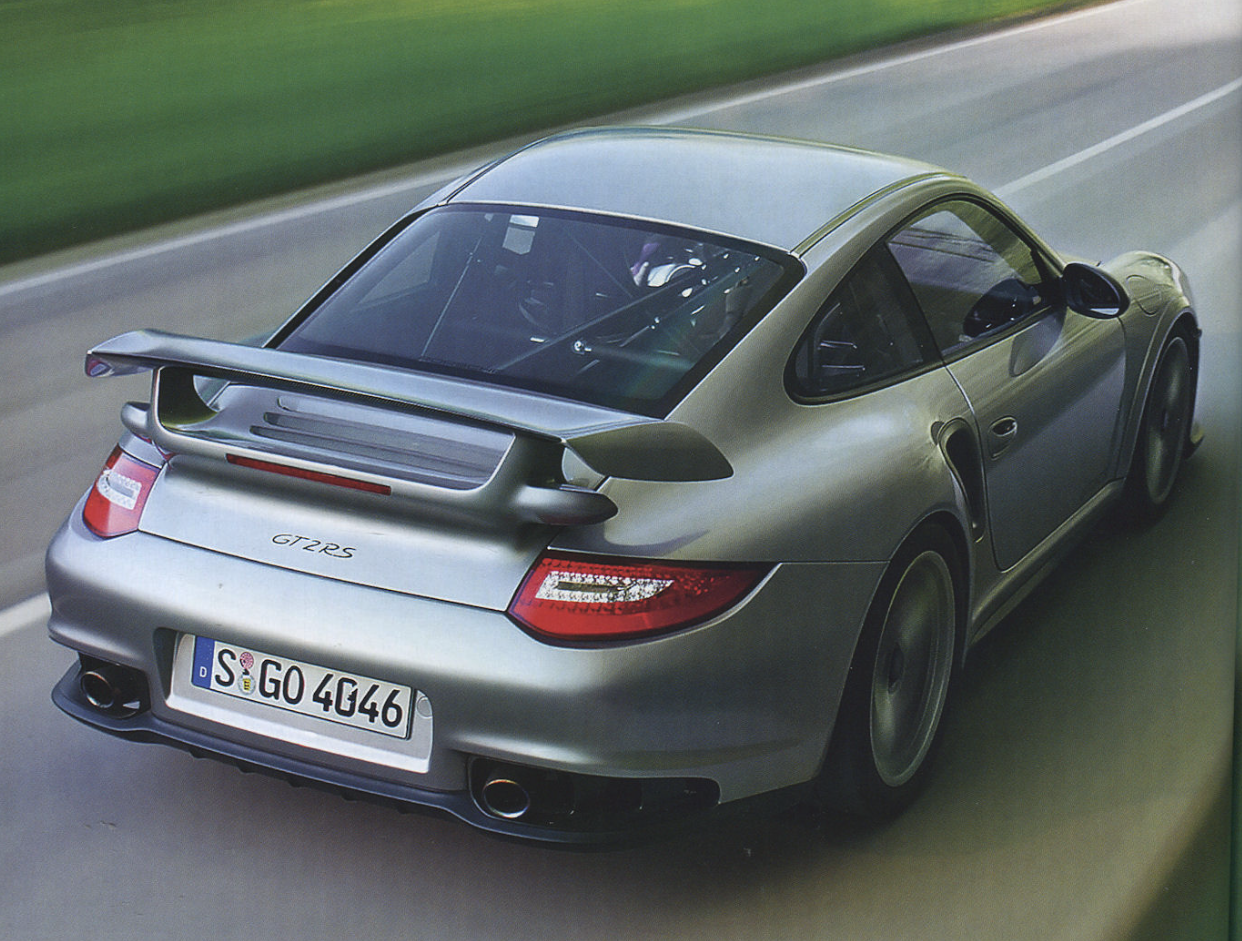
2005 - 2013 Porsche 911 (997) Driving Experience & What to Expect
The Porsche 911 (997) is widely regarded as one of the most rewarding driver’s 911s ever made because it strikes a near-perfect balance between classic involvement and modern precision. From behind the wheel, the 997 feels distinctly alive — the hydraulic steering delivers rich feedback, the chassis communicates clearly through corners, and the car responds faithfully to every input. One road tester summed it up perfectly:
The 997 feels like a conversation between driver and machine, not a filtered translation.
Compared to newer generations, it maintains a tangible mechanical connection that modern electronics increasingly soften, making it feel special even at everyday speeds.
Performance across the range is strong and engaging rather than overwhelming for most variants. Standard Carreras offer more than enough real-world pace, with a strong, linear power delivery that builds beautifully toward the redline. The Carrera S models add sharper urgency and greater mid-range punch, giving the car a more muscular feel without sacrificing balance. As one reviewer noted,
The Carrera S doesn’t just go faster — it feels more awake, more eager to be pushed.
Acceleration feels immediate and purposeful, while the flat-six soundtrack retains emotion, particularly in naturally aspirated models.
Where the 997 truly shines is handling. The rear-engine layout still defines the car’s character, but the sophistication of the suspension and weight distribution makes it far more forgiving than earlier 911s. It feels planted at speed yet playful when pushed, rewarding smooth inputs and driver confidence. Modern testers revisiting the platform frequently emphasize how intuitive it is to drive quickly, with one enthusiast noting,
You don’t fight the 997 — you flow with it.
It offers composure on sweeping roads and precision on technical sections, making it equally enjoyable on mountain passes or track days.
Variant differences significantly shape the experience. The Carrera 4 and Carrera 4S bring added stability and reassurance, particularly in poor conditions, while retaining much of the car’s playful character. The wide-body Carrera 4S also adds visual drama and a greater sense of occasion. In Turbo form, the car transforms into a genuine supercar, delivering explosive acceleration and immense grip while remaining shockingly civilised. One journalist famously described it as,
A car that can destroy supercars all morning and take you to dinner in the evening.
Meanwhile, GT3 and GT3 RS variants dial everything up — sharper steering, firmer suspension, higher-revving engines — creating a raw, focused experience for serious drivers who want track capability in a road-legal package.
As a daily driver, the 997 excels. It offers comfortable ergonomics, excellent visibility, usable luggage space, and refinement levels that make commuting or long-distance touring entirely realistic. Yet, it transitions effortlessly into a weekend performance machine. Many owners describe it as a car that makes every drive feel meaningful. As one long-term owner put it
It’s just as happy crawling through traffic as it is screaming over a mountain pass — and that’s what makes it special
For potential buyers, the 997 offers something increasingly rare: genuine emotional engagement without the hardship of owning a fragile classic. It feels modern enough to be practical, yet analog enough to remain thrilling. Whether you choose a Carrera for balance, a Turbo for drama, or a GT3 for purity, the 997 rewards connection, confidence, and enthusiasm in a way few modern sports cars can replicate.
In today’s world of ultra-polished performance machines, the 997 still feels like a driver’s car first and a product second — and that is precisely why it has earned its reputation as one of the most beloved 911 generations of all time.
A Note On How the 997 Feels in Today’s World vs Modern 911s
In today’s world of ultra-refined, technology-saturated performance cars, the Porsche 911 (997) feels refreshingly authentic and tactile. Compared to modern 992-generation 911s, which are astonishingly capable but increasingly insulated, the 997 delivers a more mechanical, human experience. The steering is hydraulic rather than electrically assisted, transmitting subtle road textures and feedback that modern systems often filter out. You feel more of the chassis working beneath you, more of the surface through the wheel, and more weight transfer through corners. Where a new 911 feels clinically precise, the 997 feels alive — and that difference defines its lasting appeal.
Modern 911s are unquestionably faster, more stable, and easier to drive at the limit, but that perfection comes with a sense of detachment. The 997 requires more of the driver, and in return, it gives more back emotionally. There’s less interference between your inputs and the car’s response, creating a level of involvement that many enthusiasts now crave. It doesn’t overwhelm with sheer capability; instead, it invites you to explore its limits. In an era where modern sports cars can make nearly any driver feel heroic, the 997 restores the feeling that skill and finesse genuinely matter.
What stands out most today is how balanced the 997 feels. It sits at the intersection of classic and modern — more refined than air-cooled generations, yet significantly more engaging than newer models that trade sensation for seamless performance. It also feels physically more compact than today’s wider, heavier 911s, adding to the sense of intimacy and connection behind the wheel. In a world dominated by digital experiences, the 997’s analog character now feels less like a compromise and more like its greatest strength.
For drivers who value emotion over efficiency and engagement over effortless speed, the 997 doesn’t feel outdated — it feels intentionally pure. It represents a moment in Porsche history when driving feel still sat at the center of the experience, and that makes it not just relevant today, but arguably more special now than when it was new.
Getting Real - Costs to Own & Maintenance
Costs to Own & Maintain a Porsche 911 (997)
The Porsche 911 (997) strikes an appealing balance between modern performance and classic character, but it remains a premium sports car to own and maintain. While generally more refined and reliable than the 996, the 997 still demands realistic budgeting and proactive care. Ownership costs vary significantly depending on variant, mileage, usage, and maintenance history, but understanding the major expense areas helps ensure the experience remains rewarding rather than financially stressful.
Routine Maintenance & Scheduled Servicing
Annual servicing for a 997 typically ranges between $800 and $1,500 for standard maintenance, including oil changes, inspections, and fluid checks, depending on whether you use a Porsche main dealer or a respected independent specialist. More comprehensive services — involving spark plug changes, brake fluid replacement, transmission servicing, and full inspections — can climb to $2,000–$3,500. High-performance variants like the Turbo and GT3 push these figures higher due to more complex systems and higher-performance consumables. Regular preventative servicing is key to maintaining performance and protecting long-term value.
Common Repairs & Known Weak Points
While the 997 is more robust than the 996, certain issues still arise over time. Early 997.1 models may encounter IMS bearing risk and bore scoring, though at lower rates than the previous generation. Clutch replacements typically cost between $2,500 and $5,000, depending on parts and labour. Suspension refreshes — including dampers, bushings, and control arms — commonly land in the $3,000 to $8,000 range, particularly as cars age past 60,000 miles. PASM components, cooling system parts, and exhaust valve actuators also add to maintenance overhead when they fail.
Insurance Costs
Insurance premiums vary based on location, driving history, and coverage type, but typically range from $1,200 to $3,500 per year for standard use. Turbo, GT3, and GT2 models can exceed this substantially. Many owners opt for classic or agreed-value insurance policies if mileage is limited, which can reduce annual premiums significantly, often into the $900 to $2,000 range.
Running Costs & Consumables
Fuel economy usually falls between 18–24 MPG, with premium fuel required. Tires for a 997, especially Carrera S or Turbo versions, range from $1,200 to $2,000 per set, while brake pads and rotors can easily run into several thousand dollars depending on specification and whether PCCB ceramic brakes are fitted. High-performance driving or track use will naturally accelerate wear and increase costs.
Parts Availability & Pricing
One advantage of the 997 is excellent parts availability through Porsche Classic and the aftermarket. Mechanical components are generally accessible, but pricing remains consistent with premium sports car ownership. Genuine Porsche parts command a premium, while high-quality aftermarket alternatives exist for cost-conscious owners. Cosmetic parts such as interior trim, body panels, and rare items for special editions can become expensive or difficult to source.
Ownership Stages & Cost Cycles
Initial ownership is often the most expensive stage, as buyers frequently undertake a “baseline refresh” to address wear items and deferred maintenance. Once the car is properly sorted, ongoing costs tend to stabilize and become predictable. Owners who invest early tend to enjoy more reliable, cost-efficient long-term ownership.
Specialist vs General Repair Costs
Labour is a significant factor. Porsche specialists typically charge $130–$200 per hour, with dealership labor even higher. While general mechanics may cost less, Porsche-certified specialists often reduce long-term risk through proper diagnosis and correct procedures.
The Real Ownership Picture
For most owners, realistic annual running costs for a well-maintained 997 range between $3,500 and $7,000, excluding major unexpected repairs. Turbo and GT variants can exceed this figure comfortably, particularly if driven hard or tracked.
Summary
The 997 rewards owners who approach it like a performance asset rather than disposable transportation. When serviced proactively and respected mechanically, it delivers one of the most satisfying and emotionally engaging ownership experiences in the modern Porsche world. Yes, it demands financial discipline — but in return, it offers something increasingly rare: a blend of performance, craftsmanship, and driving authenticity that continues to make the cost worthwhile.
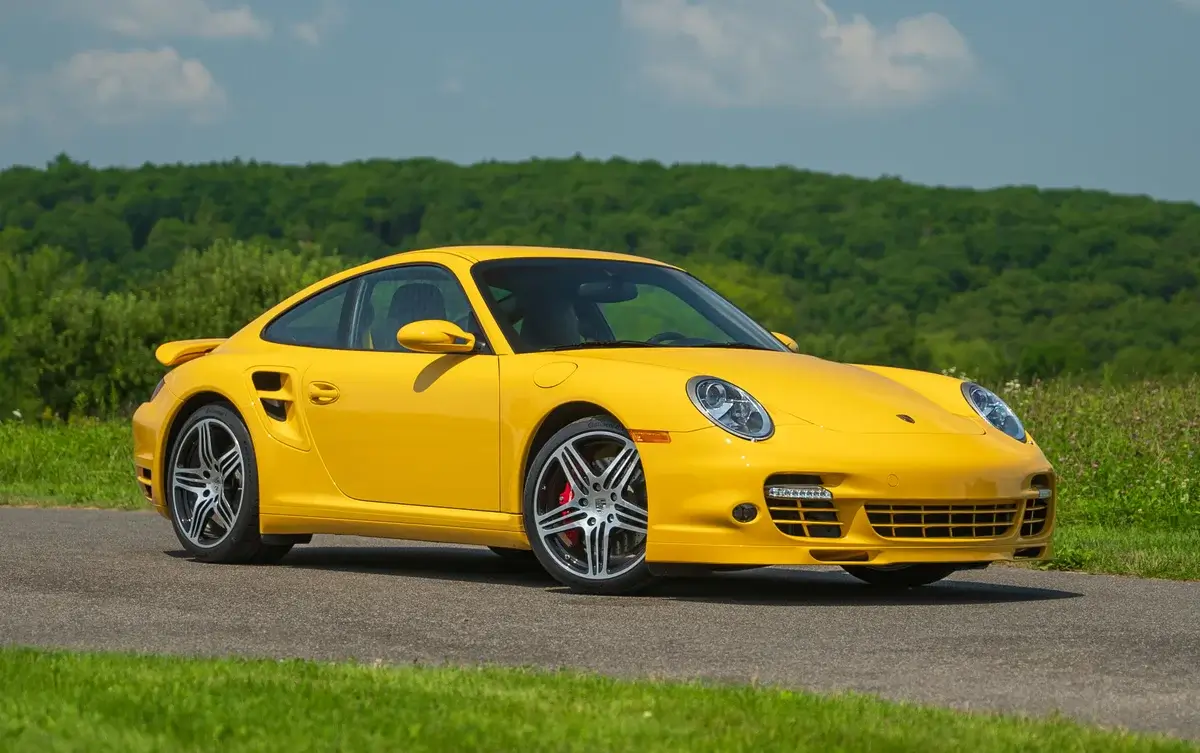
Other Key Buying Considerations & What to Look For
Ensuring Performance, Authenticity, and Long-Term Enjoyment
This Section Was Written by Kieron Fennelly
Beyond model choice and price, a successful 997 purchase hinges on a careful evaluation of the car’s mechanical and structural fundamentals. This section focuses on the critical areas that determine whether a 997 will be a rewarding ownership experience or a costly headache, including engine health, transmission performance, suspension condition, braking systems, cooling components, electrical functionality, and overall body integrity. This is where surface-level impressions give way to deeper scrutiny — examining service history, signs of wear, evidence of proper maintenance, and potential red flags that can dramatically influence reliability and long-term costs. For any serious buyer, understanding these core elements is essential to making an informed, confident decision and selecting a 997 that delivers on both performance and peace of mind.
Engine
By the time it began building the 997, Porsche had made many refinements to the M96 3.6 including its IMS installation: the bearing retaining the loaded end of the shaft was now on its fourth modification and subsequent reports from independent Porsche workshops suggests this upgrade was largely successful. While still possible, total collapse of the shaft (and engine failure) was now rare.
Some 997s on the market will have had an aftermarket upgrade to the IMS. A bigger problem is bore wear, which manifests itself in higher oil consumption and blackened exhaust tips, always signs that all is not well. Although deterioration of the Lokasil cylinder liners is often blamed, there is still no absolute consensus on the cause, though there is little dispute that it does affect the larger 3.8 engine more often.
997s that have been little-used seem more prone to bore scoring as will a car which has been driven hard while the oil is still cold. Many reputable sellers can arrange a borescope examination to set potential buyers’ minds at rest. Similarly, they should have access to Porsche’s Piwis, the diagnostic tool which will identify most engine malfunctions.
The 9A1 engine has exhibited no structural weaknesses. Porsche changed piston rings and modified bore surfaces about a year in production which appears to have eliminated most instances of bore wear. Specialists caution against low-mileage city-use only 997 gen 2s with PDK: in normal mode this changes up at no more than 2000 rpm, which eventually causes carbon deposits which clog the fuel injectors.
With their more complex electronics, there are more sensors around the cylinder head than on the gen 1: cam sensors or valve-lift sensors can fail, illuminating the ‘return to workshop’ light. These sensors often cost only $100 or so, but can require two-three hours’ workshop time.
The youngest 997s are at least 12 years old so buyers should look carefully to see what non-scheduled consumables have been replaced. The cooling system is a favourite: some experts suggest that after fifteen years, deterioration and corrosion mean that cooling pipework and water pump should be replaced anyway.
Similarly, air conditioning radiators and their pipes will usually succumb to corrosion eventually. 997s that have lived in northern states will be on their second or third batteries. Winter cold starts for those without the luxury of a heated garage put a strain on alternators too so a service record which shows a replacement alternator has been fitted is a plus point.
Transmissions
The Aisin ‘six’ has a lighter manual shift than the Getrag of the 996. Any looseness is attributable to worn bushes in the linkage, easily replaced.
Otherwise, if the transaxle has had its routine oil changes, no trouble should be anticipated. And the same can be said for the five speed Tiptronic of the gen 1 cars: ZF had by now honed the torque-converter set up to perfection and in terms of responsive yet unobtrusive operation and the Tiptro made the best of this old technology.
But there was no comparison with the PDK of the gen 2: With seven speeds and ratio-shift times far faster than the most adept manual driver can achieve, the PDK is the quicker 911 and now the default gearbox. It has also exhibited impressive reliability from the outset.
Suspension & Brakes
A 911 is a particularly dynamic vehicle which will tax its sophisticated, lightweight suspension over time and components, bushes and steering joints wear out. Uneven tyre wear—loss of inside shoulders for example is a sign that the geometry needs resetting; exposed to the heat of the engine, the rear dampers in particular deteriorate in the long term.
A test drive will reveal whether the PASM is working—the ride should become harder or bumpier if the road surface is poor. Otherwise, geometry shortcomings reveal themselves in a slight reluctance to change direction and a distinctly un-Porsche-like vagueness when cornering hard. A correctly maintained 997, especially the oldest cars, should display evidence of new suspension componentry.
Body and Interior
These 911s were properly galvanised, and any visible body corrosion is almost certainly the result of poor accident-repair work. Some stone-chipping of the front valance is to be expected; leaves get in through the front grills and if not cleaned out will compost and corrode the vulnerable a/c radiators.
The much improved 997 cabin lasts well. The state of the bolster on the driver’s seat is a useful indicator of how much use the car has had and the lighter cabin colours can exhibit grubbiness. Electrics—window lifts, mirrors, seat mechanisms and seat heating should function perfectly.
Verdict
For many Porsche enthusiasts today, the 997 is the summum of 911 achievement: an entirely modern production sports car with 180 mph performance, still relatively light (1400kg for gen 1 coupé, 1500kg for the gen 2) yet with the manual gearbox in particular, a traditional 911.
Later 911s are altogether bigger, their control systems relying less and less on the driver’s decisions. In Porsche’s defence, it must be said that the company always has to build cars that reflect the direction in which society and consumer products are going.
The 997, so similar visually to the revered 993, the final air cooled 911, is quietly becoming the modern classic Porsche. However fast and intuitive it is, the diehards will eschew PDK for the Aisin six-speed because of the greater interaction of the driving experience. Because they were significantly cheaper, the 3.6 offers better value for money than the 3.8S at the expense of fractionally less mid-range torque and a few tenths of a second to 60mph.
Yet notwithstanding, those 325 horses (345 for the gen 2) are keen to hit the red line and hurl you up the road with thrilling gusto—yes, as Sutcliffe found, the 997 can still be intimidating if you let it. But herein lies the charm of the 911, and this is the point: the 997 is the last of the analogue 911s, the total embodiment of that 911 feel.
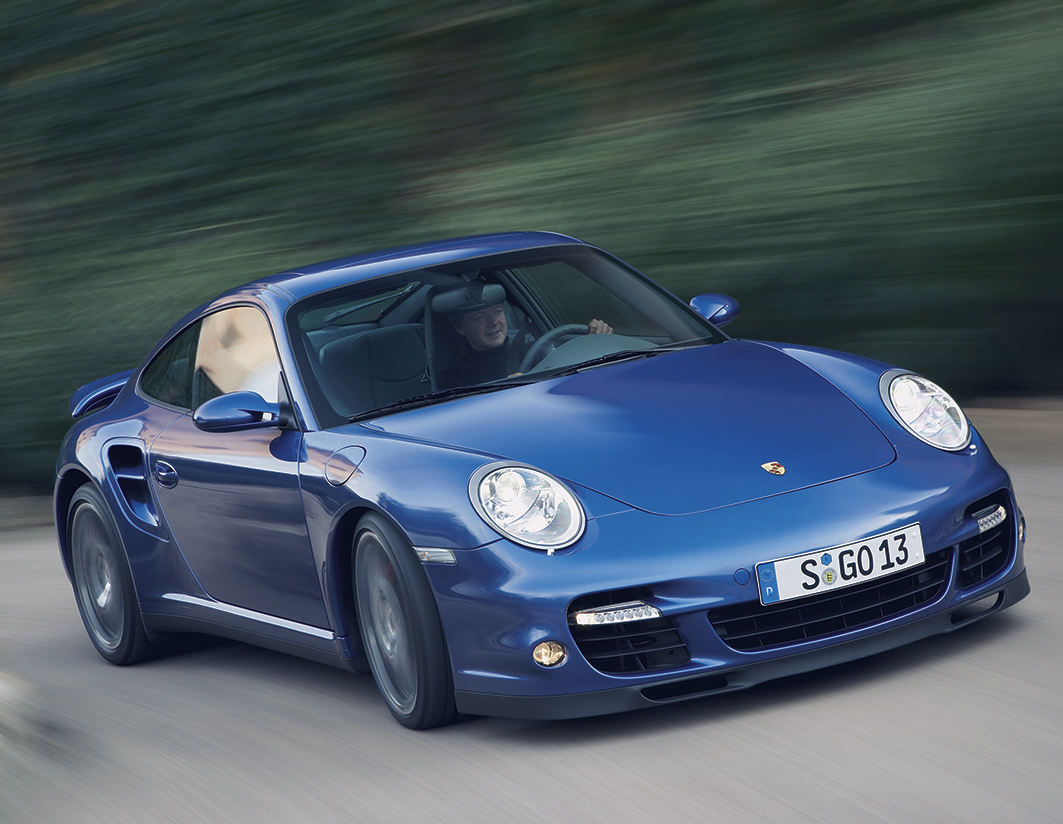
Common 997 Gen Porsche 911 Problems
What Buyers Should Know
The Porsche 911 (997) is widely regarded as one of the most beautifully balanced modern 911 generations, but like any performance-focused car—especially one now approaching 15–20 years old—it has a number of recurring issues buyers should understand before committing. While the 997 is generally more reliable than the 996, certain mechanical, structural, and age-related problems can significantly impact ownership costs if ignored.
IMS Bearing Concerns (997.1 Models)
Early 997.1 Carreras still use the final evolution of the IMS (Intermediate Shaft) bearing, which—while improved over the 996 design—can still fail. When the IMS bearing deteriorates, it can lead to catastrophic engine failure because the bearing supports the timing shaft that synchronizes camshafts and crank rotation. The failure rate is far lower than the 996 era but still real enough to influence the market. Symptoms include metallic debris in the oil filter, engine noise at idle, or warning lights, though many bearings fail without noticeable signs. Replacing or upgrading the IMS bearing requires removing the transmission and can cost several thousand dollars, but it dramatically reduces long-term risk. Cars from mid-2008 onward (997.2) eliminated the IMS design entirely, making them highly desirable from a reliability standpoint.
Bore Scoring Issues
Bore scoring is one of the most serious and expensive potential issues on 997.1 models, particularly affecting the 3.8-liter engines used in the Carrera S. This occurs when piston skirts or piston rings cause deep scratches in the cylinder walls due to lubrication breakdown, overheating during cold starts, or oil starvation. The damage can cause pronounced tapping noises on the driver’s side of the engine during idle, increased oil consumption, sooty exhaust tips, and misfires. Bore scoring typically requires a full engine rebuild or cylinder re-sleeving, which can run $8,000–$20,000+ depending on the shop. A pre-purchase borescope inspection and oil analysis (looking for metal particles) are essential for peace of mind.
Coolant Pipe Failures (Turbo, GT3, GT2 – Mezger Engines)
The 997 Turbo, GT3, and GT2 models use the legendary Mezger engine, which avoids the IMS/bore-scoring concerns but introduces its own potential issue: bonded coolant pipes. From the factory, certain coolant fittings are glued rather than welded into the engine block. Over time and heat cycles, that adhesive can fail, causing a sudden and dramatic coolant dump. This can be dangerous if it happens at speed and can lead to overheating and engine damage. The permanent fix—pinning or welding the coolant pipes—is well-known and highly recommended. A car with this work already completed is significantly more desirable and commands a premium.
Suspension Wear & Aging Components
Most 997s on the market today are old enough that their suspension systems are entering the wear phase. Control arms, bushings, thrust arms, and PASM dampers commonly develop play or fatigue. Symptoms include clunks over bumps, vague or wandering steering, uneven tire wear, and a general loss of the tight, precise feel these cars are known for. A full suspension refresh can cost $2,000–$6,000 depending on how comprehensive it is, but it transforms the car back into the responsive machine Porsche engineered. Buyers should not fear a car needing suspension work—but they should budget accordingly.
Clutch & Flywheel Wear (Manual Cars)
Manual 997s are incredibly rewarding to drive, but the clutch is a known consumable. Hard-driven or city-driven cars may need clutch replacement as early as 40k miles, while gentler usage may extend life beyond 80k miles. Replacing the clutch often reveals wear on the dual-mass flywheel, which can add significantly to the cost. A clutch and flywheel job can range from $3,000–$5,000, especially at Porsche specialists. A slipping clutch, difficulty shifting into gear, or chatter at idle are warning signs. Cars with recent clutch service are far more desirable.
Ignition Coil Pack Failures
Coil packs on the 997 are known to crack over time due to heat exposure, especially on cars driven in hot climates or pushed hard. When coils fail, owners experience misfires, rough idle, stumbling, or CEL warnings. Replacing all six coils (often recommended while you're in there) is a relatively inexpensive repair ($300–$800 depending on parts and labor), but it’s a recurring cost many owners eventually face. Cars that have lived near the coast or in cold climates often see coil pack degradation sooner.
Electrical Problems & PCM Issues
The 997 introduced a more modern interior and electronic suite, but with age, electrical quirks are increasingly common. Early PCM navigation and radio units can glitch or fail, the display can pixelate, Bluetooth modules can stop pairing, and window regulators or central locking actuators may require replacement. While most of these issues are not catastrophic, they can be tedious and somewhat expensive to diagnose due to Porsche’s electronic complexity. A fully functioning interior electronics system is a strong selling point.
PCCB (Ceramic Brake) Wear & Costs
Cars equipped with Porsche Ceramic Composite Brakes (PCCB) offer phenomenal stopping power and extremely low brake dust—but the cost of replacing rotors is enormous. Each rotor can cost $2,000–$5,000, meaning a full set can easily exceed $15,000–$20,000. While PCCB rotors last a long time under normal street use, aggressive driving, tracking, or accidental chipping can dramatically shorten their life. Buyers should inspect rotor health carefully and consider their intended usage before choosing a PCCB-equipped 997.
Exhaust Valve Wear & Corrosion
Sport exhaust systems, especially the Porsche Sport Exhaust (PSE), contain valves that can seize, rattle, or fail with age. This leads to odd noises, stuck exhaust modes, or check engine alerts tied to vacuum leaks. Corrosion in the rear exhaust sections is also common on cars from wet climates. Exhaust repairs can range from simple vacuum line fixes to replacement of the entire rear silencer assembly.
Water Leaks & Roof Drain Blockage
Like many 911s, the 997 is prone to blocked sunroof or cabriolet drains. When these clog, water can find its way into the cabin, sometimes reaching sensitive electronics under the seats (including immobilizer modules), leading to expensive replacements. Regular drain cleaning and ensuring proper sealing around windows are critical preventative measures.
Aging Rubber & Seals (Engine & Body)
As 997s age, rubber gaskets, seals, and hoses begin to harden or crack. Common leaks include rear main seal (RMS) seepage, valve cover gaskets, coolant hoses, and power steering lines. Some leaks remain harmless for years; others grow into costly repairs. A dry, clean engine underside is always a positive sign during inspection.
Final Thoughts: Should These Problems Scare You?
The 997 is a fantastic, durable sports car when maintained, and none of these issues mean the model is unreliable—rather, they are age- and design-related realities of a high-performance machine. The most expensive 997 is almost always the cheapest one with compromised history, deferred maintenance, and hidden issues.
A well-documented, well-cared-for 997 that has addressed (or avoided) these common problems can be dependable, thrilling, and enormously satisfying to own for many years. For smart buyers who do their due diligence, the 997 remains one of the best long-term ownership propositions in the modern sports car market.
Buying A 2005 - 2013 Porsche 911 (997) FAQs
Here are all the questions we've received from readers considering a Porsche 997 for their garage
What to look for when buying a 997 gen 911 in terms of authenticity & documentation
When purchasing a 997-generation Porsche 911, authenticity and documentation matter just as much as mileage and condition. These cars are now entering modern-classic territory, and the strongest examples are those with clear, traceable histories and verifiable originality. Proper documentation doesn’t just protect value — it protects you from buying a car with hidden mechanical, legal, or provenance issues that can significantly impact ownership experience and resale.
Service History Completeness
The gold standard is a fully documented service history from either Porsche main dealers or respected Porsche specialists. Look for consistent oil changes, major services performed on time, and thorough maintenance logs that demonstrate ongoing care rather than sporadic attention. Red flags include large gaps in service records, vague handwritten entries, or missing mileage continuity. A stamped service book backed by detailed invoices and dates is ideal, especially during early ownership years.
VIN Consistency & Identity Verification
Confirm that the VIN matches across the chassis, windshield, door jamb label, under the front trunk liner, and service records. A mismatch can indicate accident damage, re-shelling, or theft history. Cross-reference the VIN with Porsche databases or a Porsche dealer to confirm original build specifications and equipment at the factory.
Original Build Spec (Option Codes & Coded Sticker)
The option code sticker (typically under the front trunk lid or in the service book) reveals the factory specification. Compare these codes to the actual car — wheels, seats, interior trims, brakes, suspension, transmission type, and more. Discrepancies may indicate later alterations or replacements. High-value buyers increasingly care about cars retaining original components that align with factory build sheets.
Ownership History & Title Transparency
Fewer owners and long-term ownership generally suggest better care and stable stewardship. Multiple short-term owners can sometimes point to unresolved issues or poor maintenance habits. A clean title history free from salvage or structural damage designations is critical. Use vehicle history reports alongside physical inspection, but always prioritize physical evidence over digital summaries.
Engine & Drivetrain Matching Verification
For value or collectible-oriented buyers, verifying whether the engine and gearbox are original (matching numbers or confirmed factory replacements) adds confidence. This can be especially important for high-spec variants and approaching-collector-grade examples.
Proof of Preventative Maintenance & Known Fixes
For early 997.1 models, documentation showing IMS bearing upgrades, bore scoring inspections, or engine rebuilds (if applicable) is exceptionally valuable. Receipts showing clutch replacements, coil pack changes, cooling upgrades, and suspension refreshes indicate proactive ownership and responsible care.
Accident & Paintwork Documentation
Look for evidence of body repairs, paintwork or structural impact. Consistent panel gaps, matched paint thickness readings, and uniform factory welds indicate originality. If the car has been involved in an accident, insist on repair documentation and structural inspection reports confirming proper restoration.
Original Equipment Retention
Collectors increasingly value cars that retain original wheels, exhaust, interior trim pieces, factory stereo/PCM, and accessories. Even if upgraded parts are installed, having the original equipment included can significantly enhance future desirability.
Keys, Manuals & Accessories
Complete ownership kits — including two keys, service book, owners manual, toolkit, tire inflator, and spare accessories — reflect careful ownership and help preserve authenticity credibility.
The Bigger Picture for Buyers
In the 997 market, the most valuable cars are not always the lowest mileage — they are the best documented. A properly preserved service history tells a story of consistency, care, and confidence — and that story is what future buyers will pay for. A 997 with full documentation, factory-correct specification and trustworthy provenance is not just a sports car — it’s a protected asset. In contrast, a car with questionable history, mismatched parts, or incomplete records almost always becomes more expensive over time, regardless of its initial price advantage.
Just how important are service records and ownership history?
When buying a Porsche 911 (997), service records and ownership history are not minor details — they are foundational to the car’s value, reliability, and long-term ownership experience. In many cases, a well-documented 997 with higher mileage is a far safer, smarter purchase than a low-mile example with vague or incomplete history. These records provide a clear narrative of how the car has been treated, maintained, and respected over time, and that narrative directly influences both your risk exposure and your future resale potential.
Service records are your only real window into the car’s mechanical life.
Detailed invoices and maintenance logs reveal whether the car has received consistent oil changes, scheduled servicing, preventative repairs, and specialist attention. This is especially critical for early 997.1 cars, where evidence of proper maintenance helps reduce concerns around IMS bearings, bore scoring, cooling issues, or wear-related failures. A thick stack of documented work showing proactive care signals a conscientious owner; gaps in history suggest uncertainty, deferred maintenance, or cost-cutting — and that uncertainty often translates into surprise expenses.
Ownership history provides context that mileage alone cannot.
A 997 with two long-term owners who maintained the car carefully is almost always preferable to one that has passed rapidly through multiple hands. Frequent ownership changes can sometimes point to unresolved mechanical issues, dissatisfaction, or poor care. Long-term ownership generally indicates emotional attachment, ongoing investment, and consistent care habits — all of which increase confidence and desirability.
From a value perspective, documentation directly influences price and liquidity.
Well-documented 997s are easier to sell, attract more serious buyers, and command higher prices. As the generation continues moving toward modern-classic status, buyers are becoming far more selective, and cars with incomplete histories are increasingly discounted or avoided altogether. In contrast, strong service history acts like a trust signal — reassuring future buyers and protecting the car’s value curve.
From an ownership standpoint, records reduce stress and future costs.
Knowing when critical items like clutch, suspension components, water pumps, spark plugs, or cooling parts were last replaced allows you to plan intelligently instead of reacting to failures. It turns ownership from guesswork into informed stewardship.
In short, service records and ownership history are not just nice-to-have — they are essential. They transform a 997 from a gamble into a calculated purchase. For buyers who want both driving pleasure and peace of mind, the rule is simple: Buy the best history you can afford. Everything else follows.
Originality vs. Modified 997 Gen 911s: What’s More Valuable?
In the 997 market, the answer is becoming increasingly clear: originality is the safer and more valuable long-term asset, while modification is a personal choice that can enhance enjoyment but rarely enhances investment value. As the 997 moves further into modern-classic territory, buyer behavior is shifting from performance-first enthusiasm toward preservation-minded collecting. This evolution is already creating a visible gap between factory-correct cars and heavily modified examples.
From a financial and collector perspective, factory originality carries significant weight. A 997 that remains close to its original specification — correct wheels, original paint, factory interior, OEM components, and matching equipment to its build codes — commands stronger demand and more predictable appreciation. These cars appeal to the broadest audience, remain more liquid, and inspire greater buyer confidence. As time passes, unaltered examples become more scarce, further amplifying their value.
That said, the 997 is also widely loved as a driver’s car, and thoughtfully modified examples can still hold strong appeal when the changes are high quality, reversible, and aligned with Porsche’s engineering ethos. Upgrades such as premium coilover suspensions, improved brake systems, tasteful exhaust enhancements, and subtle cosmetic refinements can enhance the driving experience without significantly harming resale — especially when all original parts are retained and the work is well documented.
Where value begins to suffer is with poorly executed or irreversible modifications. Non-factory paintwork, aggressive body kits, interior drilling, aftermarket electronics that alter factory trim, engine tuning without supporting upgrades, or unbranded parts installations narrow the buyer pool dramatically. These changes introduce uncertainty, reduce originality, and make the car less appealing as it matures into collectible status.
The market increasingly favors cars that fall clearly into one of two camps: either carefully preserved or intelligently upgraded. Cars stuck awkwardly between — showing inconsistent vision or cheap modifications — tend to underperform and linger unsold.
Ultimately, if your goal is long-term value and investment security, originality wins. If your goal is pure driving enjoyment, modifications may enhance the experience — but they should be approached strategically, conservatively, and with documentation in mind. For most buyers, the ideal balance lies in a factory-correct car that can be enhanced subtly while maintaining reversibility and provenance.
Should I Be Concerned About a Modified 997 More Broadly?
A modified 997 isn’t automatically a red flag — but it should trigger a more disciplined and investigative approach than a factory-original car. The 997 is a beloved platform for performance enhancement, and many examples have been upgraded to improve handling, braking, drivability, or aesthetics. The critical distinction is not whether the car is modified, but how thoughtfully, professionally, and coherently those modifications were executed. A modified 997 can be an exceptional driver’s car, but it requires deeper scrutiny to ensure you’re not inheriting hidden compromises.
The safest modified cars are those that follow a clear, logical philosophy — enhancing the car’s strengths without corrupting its engineering integrity. High-quality suspension upgrades, upgraded brakes, premium exhaust systems, short-shift kits, and OEM+ style enhancements can actually make the car more enjoyable while maintaining reliability. When such modifications are reversible, professionally installed, and supported by detailed documentation and original parts, they tend to retain strong desirability among enthusiast buyers who prioritize driving experience over originality purity.
Where caution is justified is with broadly altered 997s that show signs of trend-driven or poorly executed work. Aggressive body kits, drilled interiors, hacked wiring, ECU tunes without supporting cooling or fuel upgrades, cheap aftermarket components, or unverified engine modifications increase risk substantially. These changes not only narrow your future buyer pool but can also introduce long-term reliability issues that surface only after significant ownership.
From a value perspective, heavily modified 997s generally struggle as the generation matures into collectible territory. Buyers increasingly prefer cars that are either authentically preserved or expertly enhanced. Cars that fall into a murky middle ground—neither clearly original nor purposefully upgraded—tend to depreciate harder and take longer to sell.
Ultimately, you shouldn’t fear a modified 997 — but you should interrogate it carefully. Ask who installed the modifications, why they were done, whether original parts are included, and if the work aligns with how you plan to use the car. If the execution is purposeful, well-documented, and mechanically sound, a modified 997 can be an immensely rewarding ownership experience. If not, your concern is not only justified — it’s essential.
IMS & Bore Scoring on the Porsche 911 (997). What Do I Really Need to Know?
Few topics generate more anxiety for 997 buyers than IMS failure and bore scoring — and while both deserve serious attention, they do not define the entire ownership experience nor automatically make the 997 a risky car to buy. The reality is more nuanced: these issues exist primarily within specific sub-generations and engine configurations, and informed purchasing dramatically reduces exposure.
IMS Bearing: The Legacy Concern (997.1 Only)
The Intermediate Shaft (IMS) bearing supports the camshaft timing system on early 997.1 Carreras (2005–2008). While improved over the 996 design, it can still fail, causing catastrophic engine damage by throwing timing off and allowing valves and pistons to collide. This issue does not affect Turbo, GT3, or GT2 models, which use the Mezger engine architecture.
The actual failure rate is relatively low, but the consequences are significant, which keeps the topic front-of-mind for buyers. By far the safest examples are those with documented IMS bearing upgrades or regular oil analysis and inspection history. Most specialists view the IMS issue as a known maintenance variable rather than a death sentence — and many owners choose to address it proactively when performing clutch replacements. The later 997.2 models (2009–2013) eliminated the IMS design entirely, which increases their desirability from a peace-of-mind standpoint.
Bore Scoring: The Greater Financial Risk
Bore scoring is the more serious long-term concern and tends to affect primarily 3.8L Carrera S engines from the 997.1 generation. It occurs when piston skirts score the cylinder walls due to insufficient lubrication, thermal stress, or improper warm-up, leading to increased oil consumption, tapping noises during cold idle, and eventually declining engine performance.
Diagnosing bore scoring requires a borescope inspection, as it is not always visible through external symptoms during early stages. If confirmed, repairs usually require engine rebuilding or cylinder re-lining, often costing $10,000–$20,000+ depending on severity. However, not all cars experience this, and many engines run flawlessly for decades when properly maintained and warmed up correctly.
997.2 engines show far lower incidence due to revised internal design and materials.
Should You Avoid the 997 Because of This?
Absolutely not — but you must be informed.
Smart buyers operate with a “trust but verify” mindset:
Favor 997.2 models if budget allows (no IMS, reduced bore scoring risk)
Prioritize cars with documented IMS upgrades
Always request a borescope inspection
Ask for oil analysis results
Look for long-term ownership and detailed service history
A properly maintained 997 that has passed a professional inspection can be a reliable and deeply rewarding car.
Practical Ownership Reality
IMS and bore scoring are real, but they are risk factors, not automatic outcomes. Hundreds of thousands of 997s operate worldwide without issue. The cars that fail catastrophically tend to share common traits: poor maintenance, aggressive cold driving, infrequent servicing, or ignored warning signs.
The Bottom Line
Yes, IMS and bore scoring deserve respect. Yes, they require diligence. But no — they are not reasons to dismiss the 997 as a generation. In fact, their presence in the discussion is partly what has kept some variants undervalued, creating excellent opportunities for educated buyers. When approached correctly, the 997 remains one of the most balanced, emotionally engaging, and satisfying Porsche ownership experiences available today — with IMS and bore scoring becoming manageable considerations rather than deal-breaking flaws.
What are the most sought after 997 Generation Porsche 911 variants?
The most sought-after 997 models combine key traits in that all have Mezger engines, are limited production cars, have manual transmissions and strong motorsport lineage. The also have unique design or historical significance and as the 997 matures into modern-classic status, buyers increasingly pursue these special variants as they offer emotional purity, collectible credentials, and strong long-term appreciation.
1. Porsche 997 GT3 RS 4.0
This is widely regarded as the ultimate road-going 997 and one of the greatest 911s ever built. Limited to just 600 units worldwide, the GT3 RS 4.0 features an enlarged 4.0-liter Mezger engine, lightweight construction, and extreme motorsport focus. It sits firmly in blue-chip territory and is considered a cornerstone Porsche collectible.
2. Porsche 997 GT2 RS
The GT2 RS combines twin-turbo brutality with rear-wheel drive and extreme weight reduction. It is both terrifying and revered, representing the most powerful and focused Turbo-era Porsche ever produced in the 997 lineup. Its rarity, performance and historical significance elevate it into elite collector status.
3. Porsche 997 GT3 RS
The standard GT3 RS models (3.6 and 3.8) are heavily sought after for their pure driving dynamics and motorsport pedigree. Featuring lighter weight, sharper suspension and distinctive liveries, they remain one of the most desirable modern Porsches among serious collectors and track enthusiasts.
4. Porsche 997 GT3
The GT3 is the closest thing to a road-legal race car Porsche offered at the time. High-revving Mezger engine, rear-wheel drive, and razor-sharp handling make it a benchmark driver’s car. Manual-only and increasingly rare in untouched form, values continue to reflect strong demand.
5. Porsche 997 Turbo (Manual)
The manual 997 Turbo has emerged as a modern classic with serious investment potential. Using the legendary Mezger engine and featuring supercar-rivalling acceleration with daily usability, it offers the perfect blend of comfort and extreme performance. Manual versions are significantly more desirable than PDK.
6. Porsche 997 Turbo S
The Turbo S adds enhanced performance and limited production appeal to the Turbo formula. Though often equipped with PDK, it remains highly collectible due to its specification, exclusivity and visual presence.
7. Porsche 997 Carrera 4S
Among non-GT models, the Carrera 4S stands out for its wide-body Turbo-inspired appearance, enhanced grip and strong visual identity. It blends performance, usability, and emotional appeal, making it especially attractive to collectors seeking style over outright track focus.
8. Porsche 997 Carrera S (Manual Coupe)
A well-optioned, manual Carrera S coupe remains a purist favorite thanks to its balance of performance, elegance and driver engagement. Though less rare than GT models, exceptional examples are increasingly sought after.
9. Porsche 997 Sport Classic
Produced in extremely limited numbers, the Sport Classic edition featured classic styling references, rear-wheel drive, and exclusive aesthetics. These cars are highly prized today due to rarity and unique positioning in the 997 lineup.
What are the most sought after Porsche 997 options, colors and other features?
In the 997 market, specification is the difference between “just a nice 911” and a truly standout example. A well-optioned, manual, rare-color 997 with documented factory upgrades commands stronger long-term value, appeals to a broader collector base, and stands out in a crowded marketplace. These attributes create not just desirability, but scarcity — and scarcity is the foundation of automotive collectibility. Here are the most sought-after options, colors, and features on the Porsche 911 (997) — the details that most strongly influence desirability, market value, and long-term collector appeal.
Manual Transmission (6-Speed)
At the very top of the desirability list is the traditional manual gearbox. As Porsche shifted toward PDK dominance in later years, manual 997s became increasingly scarce, and today they represent a key differentiator in the market. Enthusiasts value the manual for its direct engagement and mechanical purity, particularly on Carrera S and Turbo models. A manual 997 will almost always command a premium over an equivalent PDK-equipped car, with that gap widening as the generation matures.
Sport Chrono Package
The factory Sport Chrono package is highly sought after because it enhances both the character and performance of the car. Beyond the iconic dashboard stopwatch, Sport Chrono sharpens throttle response, alters suspension behavior, and unlocks more aggressive driving modes. For buyers seeking a more focused driving experience, its presence signals that the car was specified with performance intent from the factory.
Porsche Ceramic Composite Brakes (PCCB)
Though expensive to replace, PCCB brakes remain desirable thanks to their exceptional performance, reduced unsprung weight, and visual appeal (yellow calipers). When well-maintained and untracked, PCCB adds prestige and desirability, especially on GT and Turbo variants. Buyers place strong value on these systems when they are in known good condition.
Rare & Heritage Color Choices
Color plays an immense role in 997 desirability. While classic shades like Black, Arctic Silver, and Carrara White retain broad appeal, rare and iconic Porsche colors command premiums. The most sought-after hues include: Guards Red, Speed Yellow, Riviera Blue, Maritime Blue, Signal Green, Brewster Green and GT Silver (especially on special editions). Paint-to-sample or limited-production colors significantly enhance collectibility, particularly when paired with original paint and strong documentation.
Wide-Body Design (Carrera 4S & Turbo)
The wide-body stance of the Carrera 4S and Turbo models adds strong visual drama and contributes heavily to desirability. The wider hips give the car a more aggressive presence and are deeply associated with classic 911 appeal. This aesthetic alone often pushes these models higher in buyer preference despite modest mechanical differences.
Sport Seats / Adaptive Sports Seats
Factory sport seats, especially adaptive or carbon-backed variants, are highly prized. They improve both driver connection and visual impact while reinforcing the performance focus of the vehicle. A 997 fitted with sport seats immediately signals higher-spec intent and tends to carry stronger resale appeal.
Carbon & Alcantara Interior Packages
Interior upgrades such as carbon fiber trim, Alcantara headliners, and extended leather packages elevate the perceived luxury and exclusivity. These details are especially sought after in higher-spec models and limited editions, while still adding value to well-optioned Carreras.
Factory Aero & Performance Packages
Factory aero kits (especially on GT and Sport Classic models) significantly enhance both visual impact and desirability. Original factory performance enhancements such as X51 Powerkit, limited-slip differentials, and factory sport exhaust systems further elevate appeal when properly documented.
Option Code Authenticity
Buyers increasingly value cars that retain original option code consistency. The presence of original wheels, factory navigation unit, stock exhaust, and OEM interior finishes strengthens credibility and long-term collector desirability.
Is the 997 Generation 911 Underrated?
Yes — but in a very specific and evolving way. The Porsche 911 (997) is no longer the obvious bargain it once was, yet it still remains undervalued relative to how complete a sports car it is and how important it is in the 911 timeline. Historically overshadowed by the air-cooled mystique of the 993 and the raw modern aggression of the 991 and 992, the 997 quietly established itself as the generation that perfected the blend of heritage feel and modern performance. That understated excellence is precisely why many enthusiasts now view it as one of the most “right-sized” 911s Porsche has ever built.
Part of its underrated status stems from timing. When new, the 997 was seen as merely a refinement of the 996 rather than a turning point in its own right. Only with distance has its true character become clear: hydraulic steering, naturally aspirated flat-sixes, a tactile chassis, and modern usability without the digital insulation of later cars. Today, as buyers increasingly crave authenticity and analogue feel, the 997 begins to look less like a transitional model and more like a sweet spot that Porsche may never fully replicate again.
Where the 997 still feels underrated is in the standard Carrera and Carrera S segments. GT3s, GT2s, and Turbo models have already been embraced by collectors, but well-kept “normal” 997s continue to offer extraordinary driving engagement for relatively rational money. In a market where contemporary performance cars are both faster and less engaging, the 997’s balance of feel, feedback, and character remains a rare proposition.
What makes the 997 especially compelling is that it delivers excitement without demanding compromise. It’s refined enough to be driven daily, mechanically involving enough to satisfy purists, and modern enough to feel relevant even beside new sports cars. That versatility and emotional connection are what define a future classic — and those qualities are still not fully priced into the lower and mid-tier 997 market.
In short, the 997 is no longer overlooked — but it is still underappreciated relative to its full brilliance. And for buyers who understand its position in Porsche history, it remains one of the most intelligent and emotionally rewarding 911 purchases available today.
What are the underrated 997 gen Porsche 911 variants buyers should consider?
These underrated 997 models share several qualities: strong performance, excellent build quality, engaging dynamics, and lower entry prices due to less headline attention. As collector focus continues to shift away from pure rarity and toward usability and driving enjoyment, these cars present compelling ownership propositions.
They allow buyers to experience the essence of a 997 — hydraulic steering, naturally aspirated flat-six character, and timeless design — without competing in the inflated marketplace of GT and Turbo models. For those who value experience over trend, these variants often represent the smartest and most satisfying ownership decisions.
Porsche 997 Carrera (Manual Coupe)
The standard rear-wheel-drive Carrera, especially in manual coupe form, remains one of the most overlooked gems of the 997 range. While it lacks the visual drama of wide-body or Turbo models, it delivers the purest expression of the classic 911 formula: balanced, communicative, and deeply engaging. As prices climb for GT and Turbo variants, these cars increasingly represent a sweet spot for drivers who want authentic 911 character without paying collector premiums. Well-maintained examples with strong specification are quietly becoming more desirable as enthusiasts rediscover the appeal of simplicity.
Porsche 997 Carrera 4 (Narrow Body)
Often overshadowed by the Carrera 4S, the standard Carrera 4 offers all-wheel-drive security with a more classic narrow-body silhouette. It is an excellent option for buyers in wet or cold climates or those seeking additional stability without sacrificing everyday usability. Despite its capabilities, it remains priced attractively relative to its performance and refinement, making it a compelling value-oriented choice within the 997 family.
Porsche 997 Targa
The 997 Targa sits in an odd but appealing niche. Its large panoramic glass roof and distinctive design divide opinion, but for buyers seeking something different, it offers a unique personality that blends coupe rigidity with an open-air feel. Targas tend to trade at a discount compared to equivalent coupes, yet deliver distinctive character and increasing rarity. As the market matures, these cars are beginning to attract renewed interest from buyers looking for individuality.
Porsche 997 Cabriolet (Manual)
Convertibles often carry less prestige in collector circles, but a manual 997 Cabriolet remains an emotionally rewarding classic sports car. When specified in strong colors and good condition, these cars provide an unmatched blend of open-air driving and Porsche heritage. Their current pricing gap compared to coupes makes them excellent value buys for drivers focused on enjoyment rather than maximum resale projection.
Porsche 997.2 Carrera (2009–2012)
The facelifted 997.2 models represent one of the most underappreciated sweet spots in the range. Featuring improved engines, direct fuel injection, eliminated IMS bearing concerns, and overall refinement, these cars offer enhanced reliability and modern capability. Despite this, many buyers gravitate toward early models for price reasons, leaving the 997.2 Carrera as a quietly superior long-term choice.
Porsche 997 Carrera S (Non-Widebody Coupe)
While the Carrera 4S gets attention for its wide stance, the rear-wheel-drive Carrera S coupe delivers the same potent 3.8L performance in a purer, lighter-feeling package. It is often overshadowed visually but provides sharper handling and more traditional dynamics. For spirited road driving, many enthusiasts actually prefer its more agile character, making it a sleeper choice for driver-focused buyers.


